We managed to clear from the Tongan customs and then started the passage towards our next destination - Lau group in Fiji, which is 300 miles away. The conditions were not perfect, but good enough to head to Fiji with the wind on the nose at the start which would gradually turn towards south and therefore more beam on the sales. Since gentlemen sail just downwind, this stretch of water was not a gentlemen act of the captain. But we were very fast and after one day and a half and 350 miles instead of 300, we reached Lao Group (small island archipelago in the eastern part of Fiji). We were there illegally, since you would need to clear in before in the Savusavu, which is 100 miles more towards west. Our AIS was shut down on the approach and Captain put the broken steering cable on the deck so we could claim that we were on the emergency stop in case of a visit from officials …

Lao Group was our first taste of Fiji and what a taste! Beautiful turquoise waters with small islands, similar to Raja Ampat in Indonesia. We anchored in the small bay and were completely alone there. Very quiet and Zen like. We rested, made ourselves a nice dinner and paddled around with our dingy to explore the shore.

Not to push our luck with officials too much, our next stop was Savusavu where we did really pleasant check-in procedure and got a lot of useful information from officials regarding our stay in Fiji – way to go Fiji officials! Savusavu is a nice town in Vanua Levu, where you can grab a mooring in a really protected bay and enjoy the Fijian hospitality in Savusavu yacht club. When you walk around sometimes you feel that the ground is hot since this part of Vanua Levu actually stands on volcano and there are numerous hot springs, where boiling water flows to the surface. The locals are using this boiling water to cook their meals – how cool is that? And we even saw one local using it as a steam bath.
Savusavu also prepared a surprise for us, as we met a Slovenian boat El Mundo and had a blast with them for a couple of days. It is really good to be with Slovenian friends again and talk in Slovenian language!
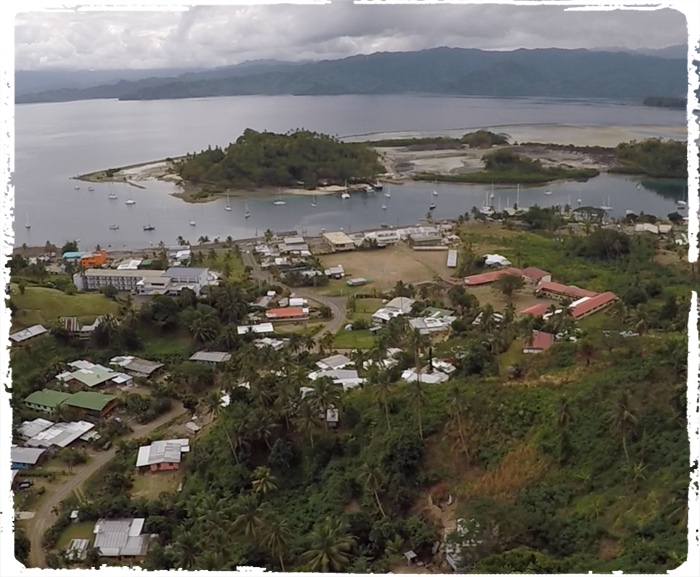


The only downside of Savusavu is that it is not a nice place for swimming, at least not in the mooring area, which we like to do very much, especially in the hot tropic environment. Our decision was that our next destination would be Taveuni island with its beaches and hiking treks. We anchored at the Matei village and asked for the local bus which would take us towards the Lavena. That is the starting point for a trekking towards Lavena waterfalls. Since we just missed the bus, we decided to hitch-hike and soon a Fijian with a pick-up truck stopped and said that he could take us one part of the road. Cool! The ride with locals always brings some new experience and also this ride didn’t disappoint. Our driver did some detour to deliver some food to his family friends and there was the horse who needed help to deliver the baby-horse. Since we didn’t know how to help the horse, the next stop was a veterinarian. But the veterinarian was not home at the moment, so the driver called him and help was arranged. Our ride finished and we were forced to wait for the local bus as there were basically no cars passing by to hitch-hike. The local bus eventually came and the ride was fast and exciting as expected, with a local music on board and a lot of warm looks and loughs from the passengers. When we arrived in Lavena, we realized why there were no cars heading in this direction to take us along – because it is a really, really small village in the middle of nowhere. We also discovered that we had only 3 hours for our walk dictated by the bus schedule scheduling the last bus to leave the village in 3 hours?? So ahead of us was a fast walk towards the waterfalls. The walking path was beautiful and jungle like with very nice scenes along the path. Actually, this was one of the best walking paths we saw so far… When we finally arrived to the waterfall, we had exactly 10 minutes for a rest and then we needed to head back not to miss the bus and stay in Lavena overnight… We were walking so fast that the barefoot local guide guiding another group asked us why such a hurry. We felt like tourists :)




Our next stop from Taveuni was a Koro island. This island was directly hit by Category 5 Hurricane Winston two years ago with winds of 300 km/h. Whole houses were blown away with casualties of 29. When we were approaching our anchorage spot, we already saw that the tops of the hills were shaved of trees. Nevertheless, below that there was no evident sign that something really dreadful had happened to the island, except for some still not repaired houses. The nature itself gave hardly any sign of demolition. It is amazing how quickly the nature licks its wounds after this kind of natural disaster. When we started to explore the shore, we were invited (as it is a usual practice in Fiji and also in a lot of other parts of Polynesia, khm, ok, Fiji is already part of Melanesia) to the tea with a Fijian family and quickly they also invited us for a dinner the next evening. The dinner with the family was the most welcoming and pleasant experience with great local food prepared by family of Roko, Lucy and their son Saki. The next move was inviting them to our boat and preparing dinner on the water… Thank you for showing us the real Fijian hospitality!


Next place to discover after our stop in Vuda marina to re-provision and to wait for our first guest on board in Pacific was the Yasawa archipelago. First stop was the Malolo island where the last preparations for Fijian regatta week took place and therefore it was really crowded. Since we had a guest on board we decided not to be present at the regatta week (and frankly speaking also we are not used to being in such crowded places) and go directly to Yasawa group islands. But before we headed towards Yasawas, we found three sailing boats with Slovenian owners or at least part of crew being Slovenian. Immediate decision was that we had to have Slovenian BBQ!

Next morning it was time to sail towards the Yasawas and good, not to strong wind took us with smooth sailing towards our first destination, the Waya island. Our anchorage was in front of the village and the custom in Fiji is to make a Sevusevu with villagers in order to be able to visit the village or anchor in front of the village. Sevusevu is a special procedure, where you visit a chief or spokesman of the chief of the village and give them kava. Kava is a root of the plant that grows in this part of Melanesia. To prepare the Kava drink, first you have to crush the root and grind it. After that you mix it with water and the drink is ready. The taste is bitter and quite special. First, after drinking kava your tongue is getting numb and then you start to relax more and more. Actually, kava effect is similar to opium, just not so strong. Maybe they drank it in the past so there were less chances for them to eat each other in possible disputes…


Next visit was the Nanuya island, where so called Blue lagoon is located, the scenery from the same named movie. We anchored in pristine calm bay and the weather forced us to be there for one week. We didn’t complain at all! It is interesting that in the Yasawas (and also among other islands in Fiji) there is a big cooperation between resorts for tourists and village communities. Resort owners are really trying to maintain the Fijian spirit and blend with Fijian environment. All of the resort staff are from nearby villages and when new guests come, they welcome them with songs. Resorts are often self-sustained with electricity (solar panels), water (desalinization), they process their waste and even have their own garden for fruits and vegetables so they can serve it to the guests. Way to go and big plus for sustainable tourism! We snorkeled a lot, walked the island paths and just had a good time.




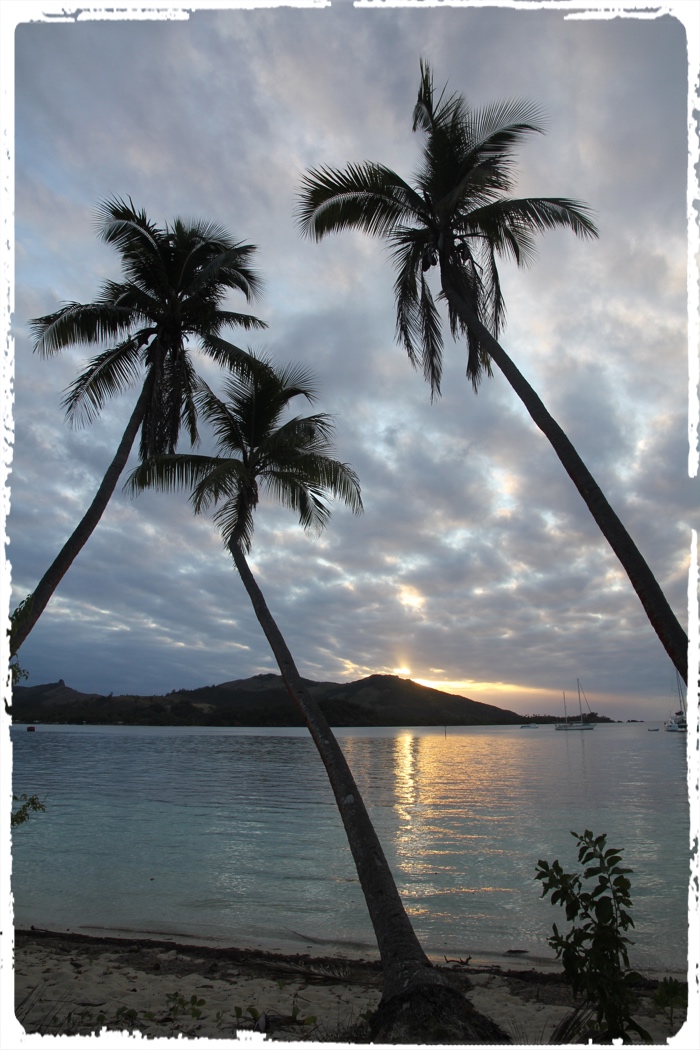


In Fiji, the hurricane season starts with November, so it is time to leave this beautiful waters before it is too late. There are two options: to go to the northern hemisphere (i.e. in Micronesia) or to head towards New Zealand or Australia to the latitudes that are not affected by the cyclones. We chose New Zealand due to the cooler atmosphere and the mountains – after all we are from the country that has the Alps and mountaineering is in our blood… Ok, it is also true that in New Zealand it can be cold. But since we will be there for the summer in the southern hemisphere, the temperatures should be at least 20 degrees centigrade during the daytime. We can live with that. One more thing, we have to lift our boat and do the paint job of the bottom since the New Zealand in 2018 introduced quite harsh biofouling rules regarding the state of the boats under water. Anyhow we have to do it – the last time we did it in Trinidad, do you remember?

See you next time!
After an overnight sailing from Fakarava we spotted early in the morning the Tahiti island. Our youngest crew members immediately sensed the first scents coming from the island and started shouting: “Pancakes, pancakes, they are baking pancakes!” It was not pancakes, it was the scent of copra, but as we always bake our pancakes with coconut oil, they recognized the scent as pancakes.
Tahiti with its capital Papeete is the first metropolitan city since we left Panama. We couldn’t wait for all the goodies that big city brings such as food stores with huge variety of products, vibrant city life, local markets,… After the passage through the reef we anchored in Lagun d‘ Arue and just a few hundred meters from the biiiiig Carrefour supermarket. When we entered the Supermarket, we were amazed by all the products inside. There are two paradises in the world – Polynesian atolls and other small islands and supermarkets. You could say that we are just another dummy consumer and we did feel that way, but only partly. The other part was just happiness. After we left Europe, Tahiti is one of the rare places where we landed with great shops as we know them from our home. After the provisioning and some welding of the boat stuff we again had a call from the wilderness so we decided to leave the Tahiti and go to Moorea Island which is more quiet and where we could swim and hike.


The sail from Papeete to Moorea was a lovely 15 miles ride with spectacular views of the island peaks, clear blue waters behind the reefs and greenery scenes. You could just sail around and watch all this for hours. We chose to anchor on the outer side of the Cook’s bay behind the reef in the turquoise blue water. After a good swim, it was time to explore the island. The island seemed a little funny at first – on one side there are resorts with “just married” couples during their 7 to 10 days’ honeymoon and they want to experience everything, possibly more islands, in a rush as then they have to fly back home. Of course, there is a lot of instant options to meet these demands. On the other hand, there is always an option of exploring the island by yourself on foot or otherwise. We decided to take advantage of both options and took a guided tour of the island which turned out to be ok as we learned a lot about the island and producing pineapples, found wild chili peppers, tested locally made Rotui juices and liquors and enjoyed beautiful views…without much effort... But on the next day, more effort was required as our captain decided for quite high mountain passage to the other side of the island. When you are off the regular touristic paths, the island reveals also its authentic part. The islands interior is a magic mixture of the plains and mountains and we can imagine why this island was chosen for filming the Mutiny on the Bounty. Moorea is known as the garden of Tahiti and has a lot of small pineapple plantations where they grow small sweet pineapples and you can buy them in a bunch of 6 on the street.





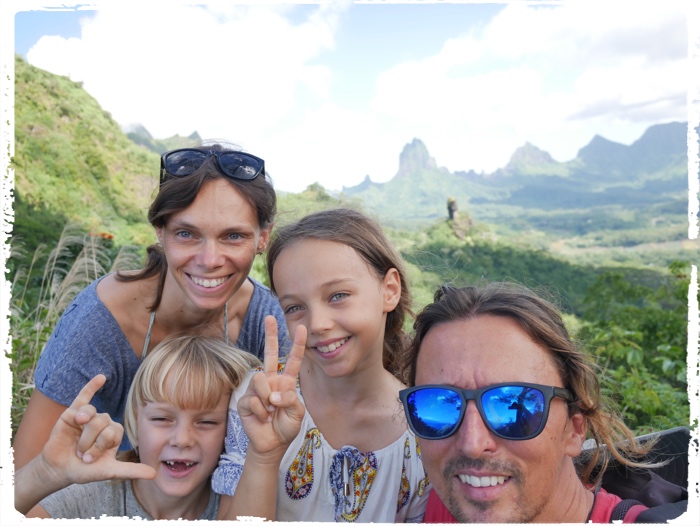

Our next stop was the smaller Huahine island which is the most unspoiled of the Societies (if you don’t count the small atolls). Till there it was 90 miles and we decided to have an overnight passage to enter the reefs in the daylight to prevent any grounding problems. We sailed slowly during the night with just 4 knots, but in the morning, the wind picked up and we were blasted towards the entrance. As we were sailing along the reef the swell was pounding on the reefs and the sound was like there was jet airplane with full throttle charging towards us. But as always, behind the reefs, calm waters and nice anchorages everywhere.

Huahine is a very quiet island with just few resorts and tourists. We hiked among the natural green garden full with bananas, papayas and other tropical fruits to choose from. Here the life is very easy, you just grab the fruits and vegetables by the walking paths and you don’t even need your own garden… We wondered why they were so cruel in the past with the cannibalism practice among the neighboring villages. Definitely the fights were not because of the lack of food. Practically every anchorage was empty and you could enjoy it by yourself and hang up with the locals.

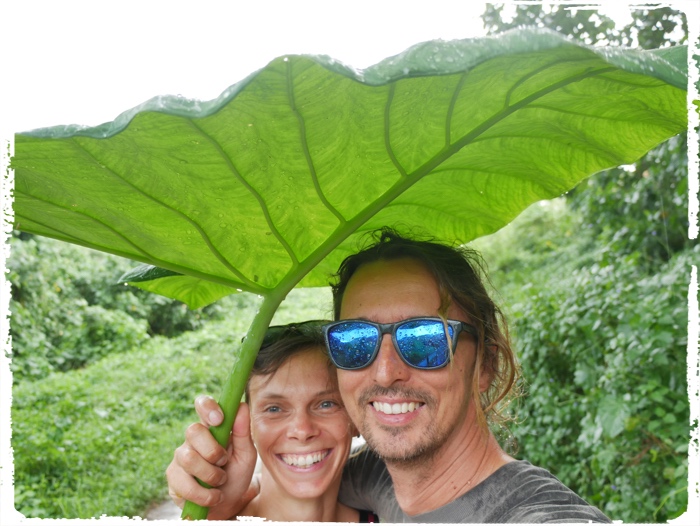


Next stop, Raiatea, is the second biggest island group (yes, there are two islands in the same reef ring) and since it was on our way towards the Cooks islands, we stopped for a while and did the check-out formalities. We were lucky to be there since there was a festival of Polynesian dances. The show started with the choir from New Zealand with Maori songs followed by the beautiful performance dance from the Society islands. When they kicked in, the drums and angry looks of tattooed Polynesians frightened you enough to just stare at how energetic the Polynesians can be. The whole show was fantastic and very well done so it could easily fit into some serious theatres back home. Sadly for us, it was time to go ahead towards Tonga. Next time we will stop in French Polynesia for much longer…
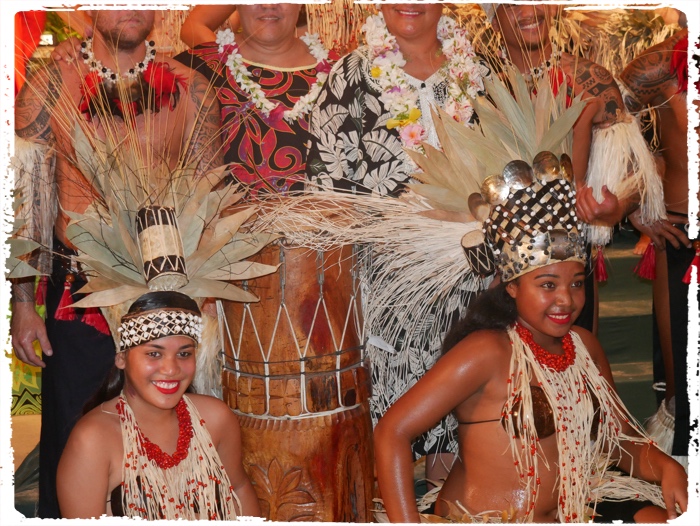
On our passage to Tonga, the seas quite picked up and after 3 days and 750 miles of rolling caused by huge waves we decided to visit Palmerston, the only atoll in Cook Islands group (among Rarotonga) that we could visit with our deep draft sailing boat. Since we could not enter into the lagoon due to the very shallow passage, we grabbed a mooring in front of the village outside of the atoll. Officials spotted us and after 10 minutes 3 officials came: Customs, Heath and Immigration. They were transported to our boat by our host, Bob. After the very pleasant check in procedure, we said that we would come ashore after we prepared our lunch. Bob said that we were not allowed to cook as long as we were his guests and said that they would cook for us! We brought with us some fishing gear and some other useful stuff since the only supply boat comes to Palmerston just once every few months. On the whole atoll, there were only 12 people while the rest of them left to Rarotonga to celebrate independence week of Cooks islands. What a crazy island this is! All the habitants are relatives of Mr. Marsters, Englishman, who in 1863 came to this island with two Polynesian wives. This small community somehow managed to survive till now on this small atoll and they are quite special. If the Hurricane came, they used to tie themselves to the trees not to be blown away… Every time after the lunch with Bob, we went to Bill¢s house for an ice-cream and it was THE ice cream – the portion was so big that we were struggling to finish itJBill is a cool guy who is specializing on turtles and was just raising some small turtles during our visit for them to have more chance to survive the first fragile months when they have a lot of predators. Then Bob had a job for us - we had to collect all the coconuts and drive them to the pig’s farm – their pigs eat just coconuts, what else they can choose from?? Slowly the weather window came and we were forced to leave this friendly and special place. Ahead of us was a 650 miles long passage towards Tonga.

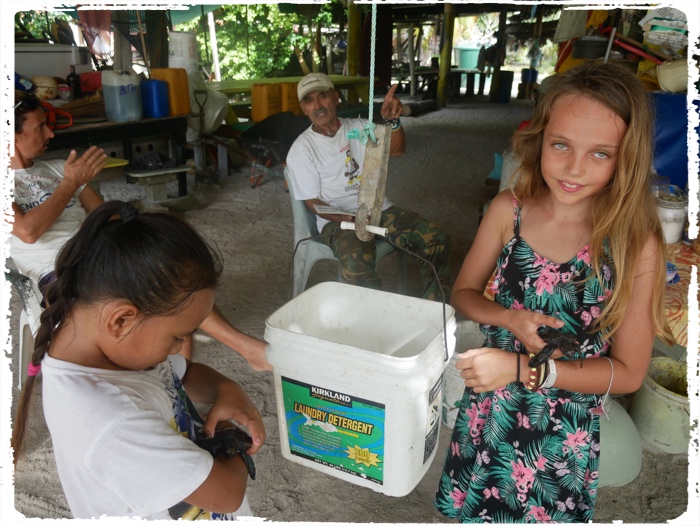

What a difference the right weather window makes. Our passage to Tonga was very pleasant with calm seas and with our gennaker the whole passage took us 3 days to be again in the protected anchorage of Vava’u Gropu, Tonga. After a very slow but nice clearance process we rested in the Neifau harbor and looking for the islands to explore in Vava’u group. The anchorages here were really nice and calm since almost all nice anchorages were really protected with surrounding reefs. Almost no swell made our nights very pleasant.

Tonga was the first place where they have kava ceremony and we were lucky to be able to try it once while attending the lovo dinner. Lovo is a special way of cooking, where all the food is prepared in the underground oven. In the Society islands, we even tried the dessert prepared in lovo: bananas and papayas wrapped in banana leaves and slowly cooked in lovo. Afterwards, they were cut in small pieces and marinated in coconut milk. Kava is actually a root of a plant and has similar to opium but milder effect. The more kava you drink, the more relaxed you are and your tongue is starting to get numb. In Tonga they usually buy the kava root already dried and powdered. They mix it with water and it is ready. For us the taste was OK, a bit earthlike. It was an interesting experience and we could understand how locals can drink kava the whole day just relaxing and even become more and more quiet until they slip in their dreams…


The highest mountain (430 m) is called Mt. Talau and besides great views also offers a tale. The mountain top is really flat, just like someone would cut it horizontally with a huge knife. But apparently, it was not always like that. Once upon a time, the Tongan Gods were bragging that they had the highest mountain in the entire South Pacific. The Samoan Gods disagreed and were upset. They also hated Mt. Talau because it spoiled their perfect view to the South. So…in the middle of the moonless night a Samoan God came to Mt. Talau and began sawing the top of Mt. Talau off. Once that was done, he began carrying it across the water. As the God was not quiet enough, he woke up the Tongan God. The Tongan God remembered a unique and important fact about Samoan Gods: they hate sunlight because it causes them to turn to stone. So the Tongan God did the only thing he could think of…he dropped his pants and mooned the Samoan God. The Samoan God got frightened thinking that he came in the contact with sun, he dropped the mountain top in the water and thus created a new island, today known as Lotuma.
The next stop from Tonga is going to be Fiji!!!
See you next time!!!
After a long passage from Panama to Marquesas in French Polynesia it was time to explore the most remote destination on our journey. First impressions of the Marquesas were exactly what we dreamed of - extremely warm people on the beautiful island of Fatu Hiva, where you could smell all the islands flowers right to your boat. What a difference compared to Panama or the Caribbean islands! The major difference was that there was no trash or any other garbage on the shore or inlands. Also, the natives have great respect for the nature and you can see everywhere how their houses and surroundings blend with the nature where they live. If you want a lift, you just rise your thumb and the 1stcar will stop with the smiling driver asking where you want to go. No one even tried to make some money for the ride. At the beginning, we were surprised by the hospitality of the islanders. We just walked through the village and locals gave us various fruits like pompelmus, oranges, bananas, limes… The flavor of Marquesas pompelmuses is superb, not at all bitter but juicy and sweet with only little bitterness in the background. We were also offered to try excellent dry bananas which did not resemble dried bananas from the European markets. They were sundried, brown, soft and delicious. And we were glad since our fruit and vegetable stock were completely gone after the passage.


People seemed to enjoy and were proud of their way of living. They were respectful to their culture. Adults were gathering in the evenings and sang together, whereas children and teenagers were playing volleyball and football on the waterfront until the dark. They immediately welcomed any new team member. Everyone really enjoyed explaining about their culture and way of life, about the art of making tiki and tapa, their food... They are still preserving the old traditions of food preparation and more importantly, also the way they behave among each other and how they welcome the foreigners, which in their culture are not visitors, but guests.

We were also surprised by the number of cruiser families in this area. Our youngest two crew members were delighted and they immediately started making friends among cruiser and local kids. Since the adults are usually more conservative with making new friendships, the kids were a great push to break this barrier faster and therefore we met a lot of very nice people and had a great time with them.
Since we wanted to see also the inner parts of the island, we decided to get a local guide who would drive us and show us around. So, we all gathered in the 4WD vehicle and together with our guide, his wife and their 6-month son started exploring the island. We were surprised by many different colors and vegetation the island provided with every new mile. On our way, we visited two craftsmen making tapa cloth and tiki-s. We also stopped to gather fresh mangoes, bananas and the Hinano flower. The Hinano flower was very hard to gather, as it grows high. Hinano flower is the main ingredient required to make a bouquet of love. This bouquet was traditionally worn by women instead of a perfume to attract men with the glorious scents:).

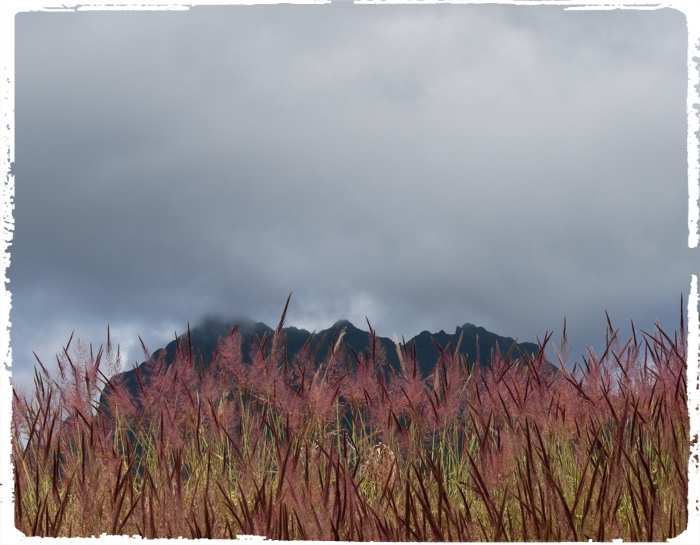

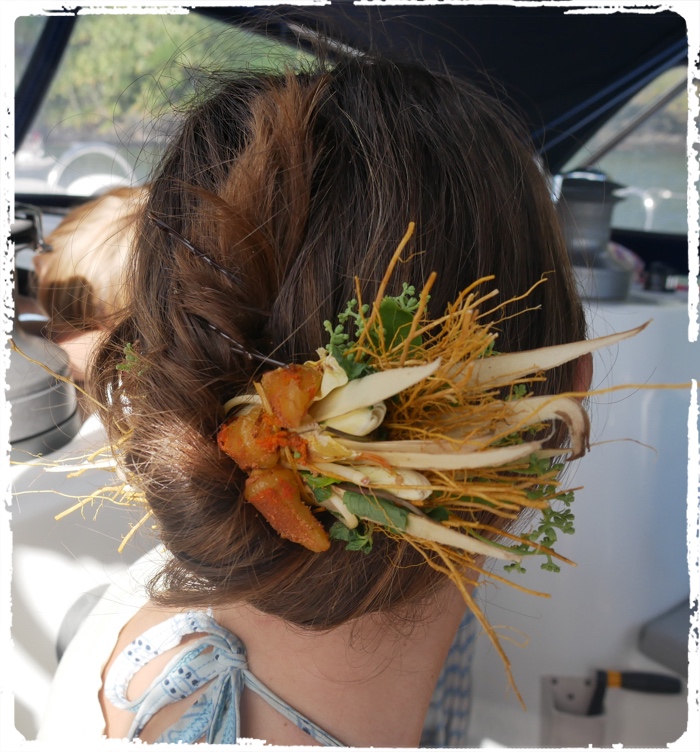


After a beautiful week spent in Fatu Hiva, it was time to clear in on the island of Hiva Oa and head to Tuamotus archipelago to snorkel, swim and dive. The formalities in French Polynesia were super easy since this is actually EU territory. We spent just 3 hours in Hiva Oa and because of nice conditions sailed immediately towards our first atoll Raroia. The passage was 500 miles long and we had the calmest conditions since we left the Mediterranean with no swell. We were enjoying our passage and also worried a little how to enter the atoll through quite tricky enter pass that Raroia has. Luckily at the entrance there were no wind and swell and we decided to enter into the lagoon even though there was no slack water time yet. Despite the nice conditions, we were barely able to enter the lagoon with the full speed reaching just 1,5 knots of speed due to the outgoing current. We were soon in a very nice anchorage in front of the only village in the atoll that populated 50 very friendly locals.



We decided to visit two more atolls, Makemo and Fakarava, before we leave the Tuamotus archipelago and head to Society islands. First of them was Makemo where we again encountered the strong outgoing currents from the atoll due to the strong easterly winds. Even though we were in front of the entrance at the right time, we were beating the currents that were up to 7 knots against us. Luckily we have a strong engine so we managed to get into the lagoon with a speed of a snail.

Makemo was a bigger atoll which was the education center of the Tuamotus. A lot of schools and students were on this island. On the anchorage, we met a Finnish family with the broken motor waiting for their part and needless to say this was a big find for our kids. The Finnish boy really enjoyed baking sweets and he immediately invited us to try one of his masterpieces. We invited them for breakfast, and so the friendship began. How quick this happens among cruisers…


In the atoll, we waited for more settled weather and then headed towards our last atoll in Tuamotus, Fakarava atoll. The entrance into the lagoon in Fakarava was the easiest, so no hassle and straight to the anchorage. Fakarava was the biggest atoll and there were some decent but very expensive grocery shops. It is funny to buy one cabbage for 8 euros... Our main purpose in this atoll was to dive and snorkel. Sharks were in abundance at the south pass of the atoll. In the beginning, we hesitated to go swimming when surrounded with all the sharks. Slowly our confidence grew, since also others have done it. We were explained by the locals at dive center that these sorts of sharks are not dangerous to humans. After swimming and diving, we decided to have dinner with other cruisers. The dinner was prepared by native, who for some time lived in Napoli and claimed he could make the best Pizza in Polynesia. Actually, the pizzas were good and baked in the stone oven and it was funny to see a Polynesian speaking Italian language.



It was time for us to head towards Society islands and also the weather window was right for the passage. We waited for the slack water, which was around noon, and we were ejected through the pass out of the lagoon and towards the Tahiti. Tuamotus and Marquesas group of islands were a great experience and we hope that someday we will return and again spend some time with extremely nice people here.
See you next time!
After some time spent in beautiful San Blas islands, it was time to cross the Panama Canal and the Pacific Ocean for our next destination, French Polynesia. For the Panama Canal, we decided that we would not use the agent, since this would just cost more with no significant benefits. The only downturn of not using an agent is that one has to personally bring the cash (and this is 2000 dollars!) to the Bank in the heart of the Colon city. Needless to say, Colon is one of the most dangerous places to be in Central and South America. And to make things even more pleasant, just on the day that we decided to bring the cash to the bank, the demonstrations took place in Colon and 3 people were shot. Hugh, we felt alive on that day. Other than that, the preparations for the transit were smooth and very easy. So, on the day of the transit, we had extra help of Captains'father and mother and also one more line-holder, Grega (thank you all the line holders!). We started the transit with first 3 locks, which job is to lift the boat to the level of the Gatun lake, which is 18 meters higher than the Atlantic Ocean.
Then, the motoring through Gatun lake took us 10 hours and at the end there were additional 3 locks, which brought us back to the sea level, this time, of the Pacific Ocean! What a great short cut the Panama Canal is… If it didn’t exist, we would have to go around the Cape horn and instead of some 50 miles, we would have to make it more than 10.000!!!
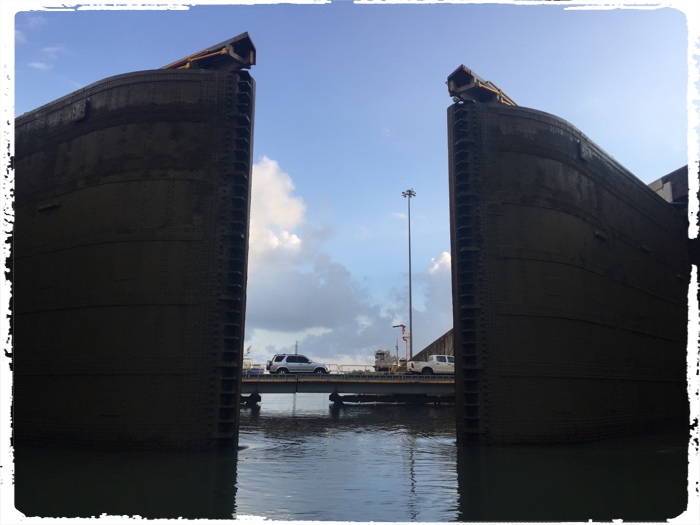


The first stop for us on the Pacific side was Balboa yacht club, where you can grab a mooring buoy and have a nice expensive rolling stay. This was the reason why we stayed on the buoy just for 2 days, enough time to stock up on fresh fruit and vegetables. We visited the Panama City open market and the views were spectacular. The strongest memory of the Colombian market is the huge variety of fruits and vegetables. On the other hand, the market in Panama City was special for amazingly huge quantities of pineapples.
Then we headed towards the Perla’s Islands, nice archipelago just 50 miles from the Panama City. Our first island to visit was Isla Contadora which is the island, where the wealthy Panamanian have their villas to spend some time off the crowded Panama City. The Island provided us with calm anchorage, so it was time to explore it!
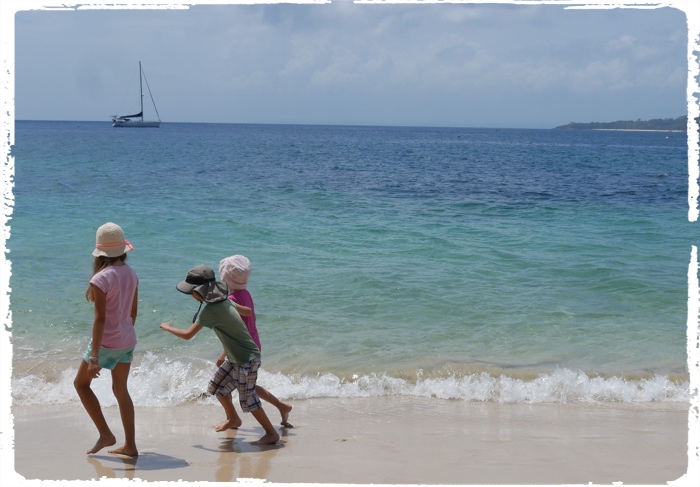

After the Contadora island we visited also other islands and Isla Las Perla’s was a really nice experience. The islands are wild, not developed and definitely not crowded. Also, Survivor series were filmed here. Soon it was time to go back to the Panama City anchorage to start with the preparations for the Pacific Crossing and two of Zana‘s permanent crew members had to fly back home for the school exams!
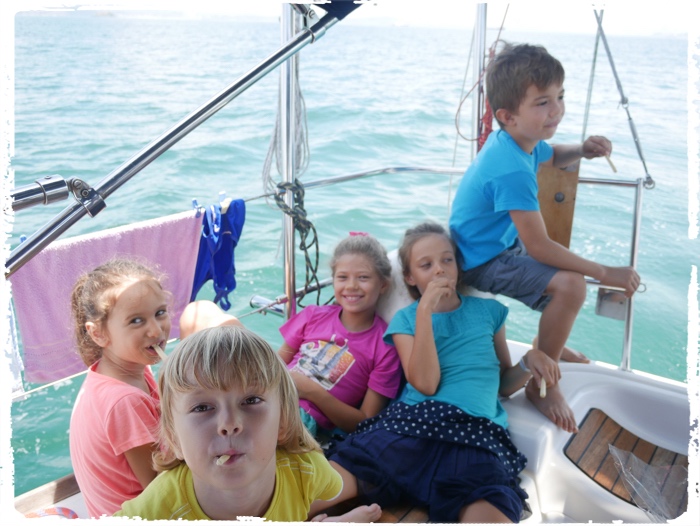
Captain and Zan decided to wait for the other two crew members to come back from Slovenia in Marina Vista del Mar. The marina is totally new and they have special price promotion, oh yeah! Since we had time we decided to visit the Indians and its shaman so he could perform the dance for us to have calm seas and nice wind for the Pacific crossing.


We must admit that we were quite nervous for this passage. First of all, it was the longest passage that we ever made, just a little shy of 4000 miles. To put this into perspective, this is the distance from Slovenia to Burma with the speed of slow cycling. Second of all, the Pacific Ocean usually has a big belt with no wind around Equator which is called Doldrums or more sophisticated ICTZ zone (Inter Tropical Convergence Zone). This is the zone, where it is high pressure between Northerly and Southerly trade winds. When you are in this zone, the only option to move is to use engine. But with such a big distance, if the zone is too big, you just don’t have enough fuel to motor through which means that you can get stuck for days or even weeks waiting for wind to come… And of course, there are some low-pressure disturbances which can make a passage also quite rolly and unpleasant. But after all, it is just water and wind and as long as the boat is not sinking, we should be just fine.

We were surprised that immediately when we set sails, the southerly wind started to blow and after 6 days, we were already north of Galapagos Archipelago. There the wind because of the islands died. It was a good timing since we had to repair our sails and our side window which was leaking. The Captain was first sure that the oldest kid crew member had a peeing accident during the night as he found her bed wet. After that wet-bed-reasoning was dismissed, the Captain headed into the galley to find other more possible reasons. A few minutes later he came into the cockpit declaring that we were sinking and searching for a big black plastic bucket! To make things even more dramatic, a big wave came crashing on our boat at that exact moment leaving the salty water everywhere. What do you do with such news? Well, we decided to continue reading the book we were reading and to allow the Captain to locate and further assess the severity of leaking and the likeliness of real sinking. The kids were able to focus on the reading only after I assured them that all our food simply could not be under water as we had lots of food in the refrigerator in our cockpit which was in our eye-sight and definitely not under water. The food of course is no. 1 concern if you are a hungry cruising kid used to occasionally skipping meals due to severe sailing conditions. The limited quantities of dry foods in our grab bag simply wouldn’t do! As for our Captain, for a short period of time he really was convinced that we were sinking as the amount of water in our boat simply wasn’t negligible and in his words - it is not a nice feeling when you are 500 miles from the shore. Side windows should be forbidden in sailing vessels as they create nothing but problems. And have you seen how huge and low set, just above the sea level, are the side windows in newer sailing vessels? I do wonder how much water gets in when such windows start leaking or even worse, fall off…
After the repairs, the wind picked up and we were sailing towards our destination with the speed that allowed us to make around 200 miles per day in the average.


We were very lucky on our passage since the ICTZ zone was nonexistent at that time due to the strong disturbance in the south which gave us a steady southerly wind and we soon knew that our extra diesel that we carried in jerry cans would remain untouched. Thank you, Indians, for good performance dancing!!!
So, the days were passing. One would think that it is extremely boring on the passage. On the contrary, it is always something that keeps you occupied. For instance, if you are leaned on the starboard side for all of the time, the toilet’s water intake is above water line which makes it almost impossible to flush. The solution is direct disposal which with the speed of 10 knots can have a note of adrenalin rush.
And there is also fishing. When fish with more than 10kg bates on the line, it is quite a job to take her on board. After the fight is done, you have to file her and prepare her for the refrigerator which also is quite a task. Cooking on the passages also takes a little more time since you are usually not in a perfect position to prepare the ingredients and often you have to search them all over after the wrong wave came. Kitchen with as much as possible leaning and holding options is the best. Especially leaning against something is very practical as it leaves both hands free for the cooking job.

During the night, we had two watches, first was from 8:00 PM till 3:00 AM and the second was from 3:00 AM till 8:00 AM which was fine and not to exhausting on the long run. What to do on the watch? Since the Pacific Ocean is sooo big, it is almost impossible to see another boat on the watch and if you hit one, you have a great talent for lotto and you should spend more time in the Casino! But nevertheless, we saw some large fishing boats on the way and none sailing boats. The watches were half sleeping state with the alarm clock set on so we could regularly check the horizon and made some necessary sails adjustments.
After 21 days and 23 hours we finally saw a marvelous green color of the Fatu Hiva island in the Marquesas. We were at sea for so long that we were just staring at the island and at the same time we were quite nervous how to throw our anchor. Will we be able to walk straight on the land – will our legs listen to our commands??
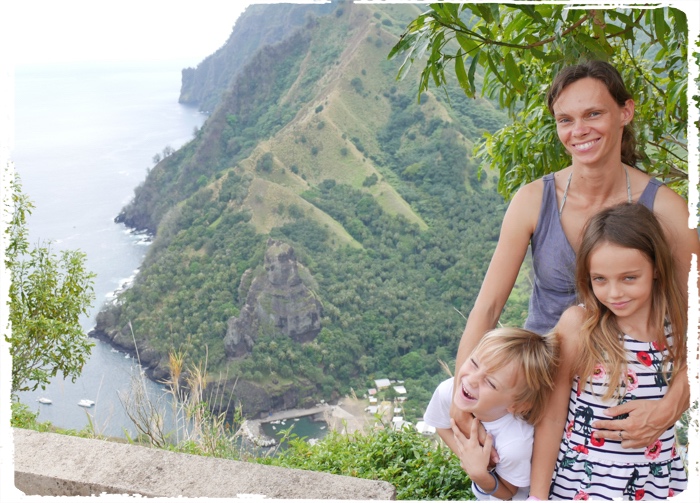
Our plan now is to explore Marquesas and then go to Tuamotus archipelago to spend time in atolls and experience swimming with sharks and do snorkeling around coral reefs.
See you next time!
The bad reputation of the passage from Netherlands’ Antilles to Colombia came into life with the confused sea and wind up to 60 knots when approaching Santa Marta, Colombia. This was one of our worst passages and even when we approached the Santa Marta marina, the wind was still gusting up to 50 knots.

To moor our boat in such conditions without bow thruster was a crazy one shot opportunity and we made it with a full throttle directly to our spot, where we stayed for the next 15 days in our mission to explore Colombia. The first impression of Colombia was a lot of street life (also at night), good food, good street market, friendly people and safe environment. Immediately, Colombia became our favorite destination in the west side of Atlantic Ocean.

The Santa Marta streets offered a lot. You can’t get by Arepas sellers not to try one. This is a thick tortilla filled with cheese or some other ingredient and very tasteful. Also in every direction, there are a lot of people selling domestic vegetable, fruits (whole or already sliced), coffee or some other home made products. Totally different than in the Caribbean islands where all this was scarce. Abundance and huge variety of incredibly tasteful fruits and vegetables was a giant plus for us. We tried and fall in love with so many new fruits, such as lulo, mora and pitaya. At the same time, we enjoyed everything we knew from before like mangos, papayas, pineapples, avocados, fig bananas and all sorts of passion fruits. And surprise, also in the evenings there is a lot happening and there are no empty streets till late at night, yeah! There is a lot of street artists, from teenagers to adults. We also loved their “Juegos naturales” which were a fresh natural fruit smoothies. Very cheap (around 1 EUR per serving) and very tasteful with a lot of exotic fruit combinations. Our favorites were made of lulo, mango and passion fruit and from mango, lulo and mora.
We were impressed by their museum and spent two days there. The artifacts, also gold ones, were splendid and so different from the ones we saw around the Mediterranean.



After we rested for a couple of days, we decided to go hiking in the Minca national park. We got on the public transport and drove into the Sierra Nevada mountains with the highest peak over 5000 meters. Almost all the hikes ended with the waterfall so it was just a matter of choice which one to visit. Along the way to the waterfall we admired very big bamboo trees which were higher than our mast on Zana.
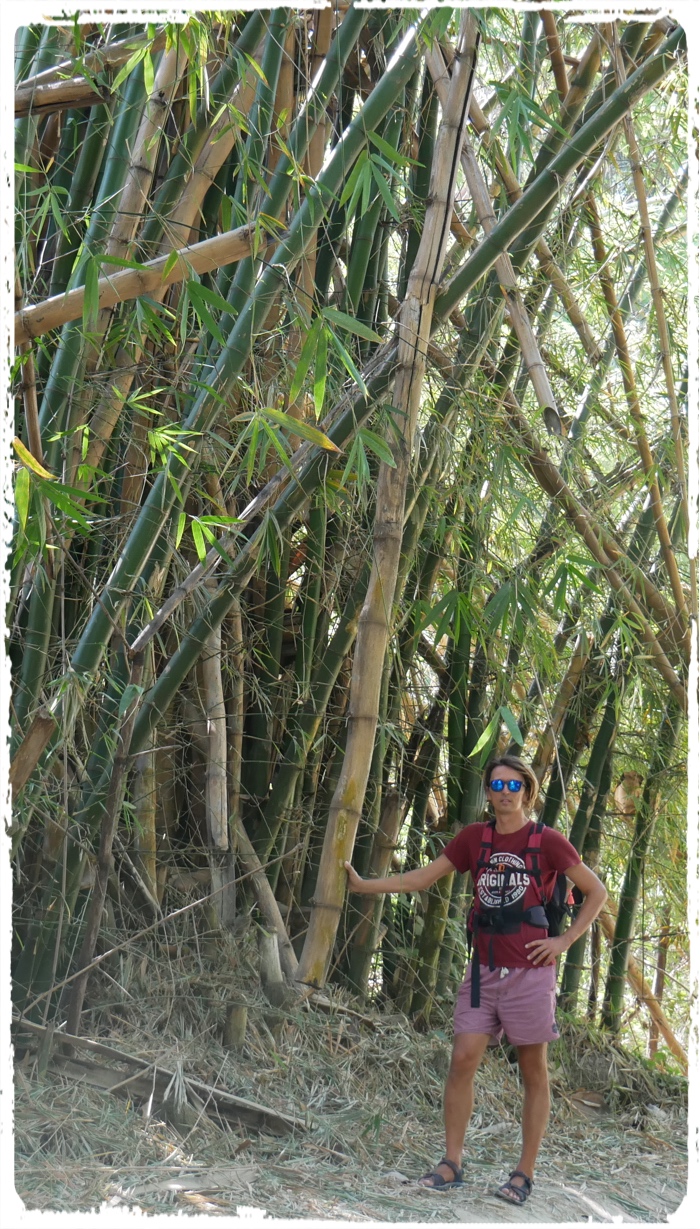
As we were walking towards the waterfall, there were a lot of small flies eating our legs, so we walked rather fast trying to avoid them. The reward for the hike was a waterfall with a pool for refreshment and rest before we headed back to Minca.

When we came back to the Minca town, we wanted also to see the chocolate factory which was some 10 kilometers in the jungle but we didn’t have enough time to do it by foot. The only way to get there was with the motorbike since the roads were very, very bad. How to get 4 people on one motorcycle?

The road was so bad that it took us 45 minutes for 10 kilometers. Žan was in the front row so he constantly reminded the driver about the holes and other dangerous obstacles on the road. Since we could rent motorbike only for 2 hours and spent so much time for the ride itself, we only had 30 minutes for the coffee factory (we missed the turn for the chocolate factory), but hey, we tasted coffee and coffee cake. Not to mention the smell of freshly roasted coffee beans…


A few days of resting after our Minca adventure and we already had new adventure in mind – to visit Cartagena. Since sailing to Cartagena requires hiring another agent and payment of 100 dollars for it, we decided to go to Cartagena by bus and to oversleep there in Airbnb accommodation. First shock was how good and cheap the BUS connection was. The bus was very comfortable, like first class flying with the airplane. You could almost make a bed with your seat and every seat had its own television with multimedia and games – yuppie for the kids! When we asked them afterwards of their favorite memory of Cartagena, they were unanimous – the BUS :). As we approached Cartagena, high buildings and skyscrapers were the first indicator that Cartagena is much larger than Santa Marta. First we found our neat apartment and guess what, this was our first land based overnight stay since we left our home one year ago!

Cartagena is really colorful city and has an old and new part. Old part has lovely old buildings with a lot of bars, restaurants and shops and on contrary, the new part is covered with skyscrapers. We liked the old part more… We visited a naval museum and in the museum, there was the simulation of the warship and submarine, so we could play a real marine war with kids. Don’t know who enjoyed it more :)
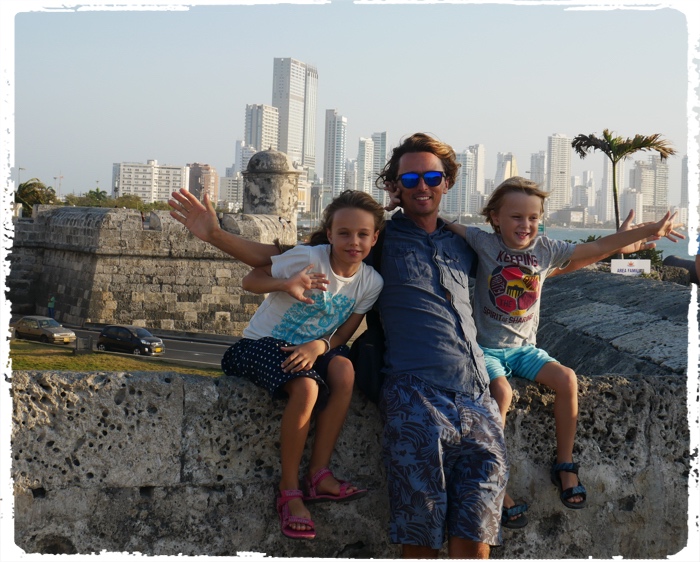

It was time to clear out from Colombia and sail to Panama to prepare for the Panama Canal. But to do this first we had to wait for the right weather since there was still blowing a steady 30 to 40 knots outside and we didn’t want to be shaken and stirred on our passage to Panama. In the end, we decided to go and the beginning was quite promising and we thought that the passage would be more or less bearable. But when the night was approaching, the wind started to grow and with the wind the seas started to build up. All of the sudden there was a difficult situation and during the night we accidentally gybed for 3 or 4 times – not funny at all… After all this nightmare on the sea, we were rewarded with San Blas archipelago, with the most beautiful scenery and beaches in the Caribbean basin. San Blas is in Guna Yala region where Indians – Kunas are still living the way they lived before the white man colonized central America. Kunas were very interesting to us with their simple homes and quiet living. They also preserved the reefs around their homes so the reefs were even more sound than in Bonaire national park – amazing. We hope that San Blas will stay as it is also in the future.
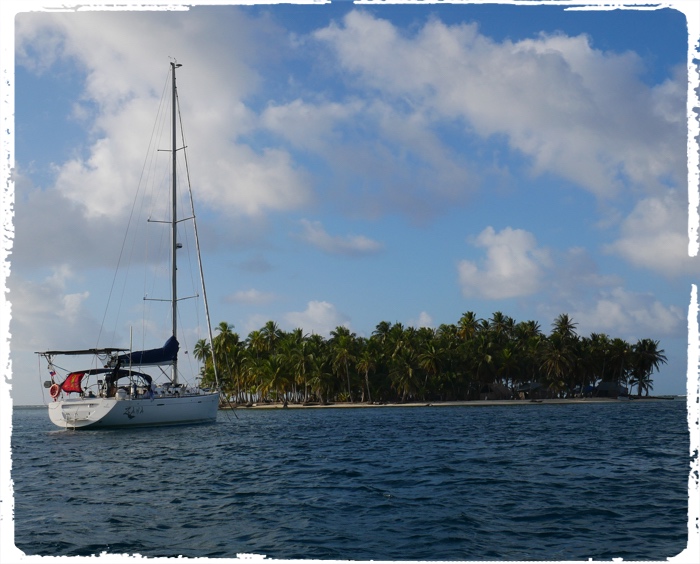


There was one thing however that we disliked throughout the Caribbean and also now when we are travelling further on. It is one special scenery, one caused entirely by humans. Doesn’t even have to be humans living there that caused it, it could be humans from miles away… Do you know what we are writing about? It is not nice but we frequently take pictures of such sceneries and we also decided to publish one here to encourage everyone to limit his or her trash to minimum, to properly handle the trash and recycle as much as possible.

This picture was taken in Sun Blas, on the windward side of the island. Out of curiosity, we checked the labels and some of the plastic stuffs made a really long way. Most of them such a long way that the labels were long washed of.

The surprise for us on San Blas was also meeting with Slovenian sailor Jasmin (you can follow him on www.jasminjadranje.si) and to have two Slovenian boats in San Blas must be some kind of record! We have sailed together since San Blas and will help each other for Panama Canal transit.

With Jasmin, we decided to go spear fishing since it is very hard/impossible to get any fresh fish or meat there. The lobster hunting season was over, so we focused on crabs and after 4 caught crabs we decided that it is enough for crew to feed. Jasmin made a very tasteful risotto on board of Zana and we had a wonderful evening!


It was time to leave the San Blas and anchor at Portobello to start working on the process of preparing for the Panama Canal. But before we did that, we decided also to visit the Rio Chagres. This is the river that fills the artificial Gatun Lake and made Panama Canal possible. You can enter the Rio Chagres by rather dangerous entry surrounded by reefs and shallows. But once you enter it, the navigation is simple and safe with plenty of water beneath the keel. What a scenery, it was like being in Jurassic park when sailing upriver! Numerous birds and other sounds (which we then saw was troops of monkeys) filled the green scenery of jungle that stretched right to the river. We dropped our anchor at the end of the river where the dam protects water from Gatun lake to spray into the ocean. We could hear the big ships transiting through Panama Canal locks.



We really enjoyed the hikes around the jungle. The hikes were forbidden and two times we were escorted back to the boat by the Canal authorities, but hey, they were super nice and it was worth it :).
Now we are waiting in Portobello for Panama Canal and do a lot of provisioning for our passage to Marquesas (French Polynesia) which will be our longest passage till now (3800 nautical miles). But more of that, next time!
Now, after 3 months spent in the Caribbean basin, we can call ourselves the true Caribbean sailors. As sailors, we found the Caribbean always windy and thanks to the trades, the wind steady and always from ENE. We stopped frequently checking the weather since there were no changes during our 3-months period – wind from east, 15 to 25 knots. Period. So, you can always anchor on the predicted anchorages, there is no turning around your anchor, waves are always from the same direction… These conditions are much easier to predict and sail in comparison to our experience from the Mediterranean or the Adriatic Sea where we are from. But there is one little difference – the waves. The waves here are much higher since the trades have the time to build them all the way across the Atlantic. Sometimes, they really are incredibly high and the sailing uncomfortable. This is the only downturn of sailing in the Caribbean but this downturn is sometimes a game changer. Personally, we vote for Mediterranean confused wind with relatively flat sea. We think also our visitors would agree since almost all of them were sea sick and most of them puked over the rails, while others were concentrating on the horizon or lying flat in the cockpit resembling dead bodies :).
It happened a lot during our stay in the Caribbean and to sum it up, this is what we liked the most:
- hanging on the beaches and snorkeling with turtles and giant starfishes in Tobago Cays,
- hanging with locals and exploring the inside of the Grenada island,
- exploring the mix of cultures and food in Trinidad, and
- snorkeling and diving in Bonaire.

In general, we were a little confused about safety in the Caribbean islands since we learned from a lot of blogs (mostly written by US cruisers) that these islands were dangerous with high percentage of robberies and thefts. We never had any problem during our stay and always met very polite locals who helped us with whatever we needed. Maybe we were just lucky enough but we don’t believe so – we believe that in general if you are respectful to the locals, they will also be respectful to you as in all other parts in the world. In Grenada, our favorite trips were visits of the interior on foot. The part “on foot” is in our opinion crucial. One can always take a taxi directly to waterfalls or whichever other destination, but in doing so misses so much wonderful opportunities to meet and talk with new people! We always met farmers and mountain people on our walks who taught us about their plants, all unfamiliar to us, and offered us to try something here and there. We didn’t even imagine that cocoa fruit has such a good fruity flavor, completely different from the chocolate flavor (the white stuff). We didn’t know how nutmegs grow and that the entire fruit and not just the core (seed) is edible. We had never before tried mangoes directly from the tree and didn’t know which greens are edible and how to prepare them. For the adult part of our crew, these experiences were far better than the destination itself, whereas the kids would probably vote for jumping in the cold water pool of the waterfall :).
Trinidad was the only island where our feelings as to the safety were mixed. We never had a problem there and met really nice people in the dockyard where we were maintaining our Zana, but we received several warnings with respect to the safety. From people in the dockyard we knew, as well as from complete strangers. For instance, during our visit to Port of Spain a lady stopped us and said: “It is OK for you to be on this street, but do not go any further as it is not safe for you further on. Turn around toward the town center afterwards.” After we took some pictures another lady approached us saying: “What are you doing?? Put your camera away!! It is dangerous to show it like this!” To sum up, we were advised to be careful and to avoid certain areas. So, we listened and further enjoyed our stay on the island.
After we made a landfall in Barbados, we headed towards Martinique, French island. It was quite weird to be back in the EU and be able to call home with domestic fees (thanks to the Roam like at home directive:) – other story was the network reliability which was very bad. We found out that the network infrastructure in Martinique was still under repair from the 2 hurricanes that roared through the Caribbean just some months before.

In Martinique, we had a lot of hikes and after the Atlantic passage, we needed it. The trails were very green. It was quite challenging to stay dry during the hike, but in the end, we were in tropic climate which is better than foggy cold winter at home:).
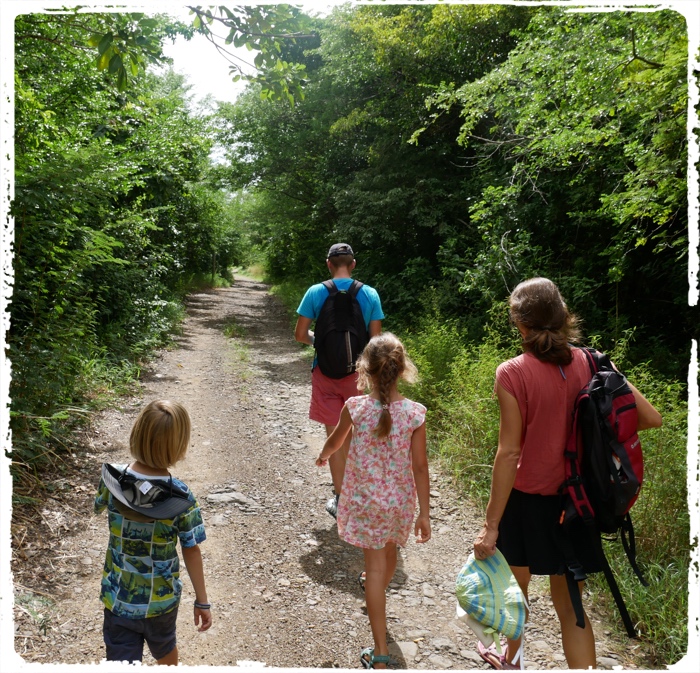
After Martinique, our next goal was sailing to Saint Vincent and the Grenadines. We were lucky to have the company of two of our friends. Not only because of excellent companionship, but also because we somehow managed to delete most of our photos of the Caribbean. The photocredit for most of the photos of this blog therefore goes to our guest Anckapomarancka.
We decided to skip Saint Lucia since it was full of ARC members that just crossed the Atlantic. Since we prefer quieter anchorages, we think this was wise idea. In the Grenadines, our first stop was the beautiful island of Bequia, where we made a clearance and anchored in turquoise waters. Our hike to the other side of the island rewarded us with excellent views and friendly local fishermen. We also had our first lobster in the Caribbean there and for that the fishermen found us 3kg heavy lobster. So, the dinner was set.

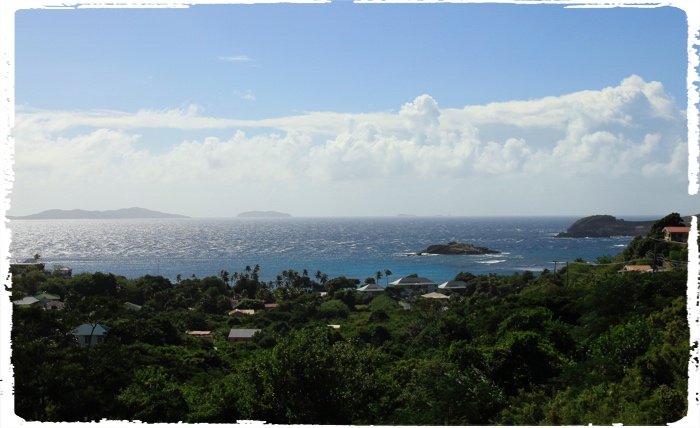

What is funny in the Caribbean is their public transportation. Every island organizes it on its own but all have one common thing – crazy drivers! To prove this: our youngest crew member did not throw up during the Atlantic passage but on the public bus, did:).
But at the end, they are fun 1 euro rides, you just have to be concentrated and always look at the horizon – maybe they are practicing with these rides for some transatlantic race, who knows… And truthfully, especially in Grenada and Trinidad they provide very efficient service.

Our next stop was, as a lot of people tells you, the most beautiful part of the West Indies – the Tobago cays. Tobago cays represent the small islands and reefs group. It is a national park so fishing is limited and therefore also the coral reefs are more preserved. We sailed there or in other words were blasted there with strong trades in our beam and spraying all over the boat. After a rather tricky navigation between reefs, we managed to anchor in the middle of the Bateau Cay which is considered as a lottery win, since there is a lot of boats that want to anchor there. The place was amazing with really clear water and excellent snorkeling on the beautiful reef. Also, all around us were turtles so you could literally swim with them while snorkeling and they were not afraid doing their everyday business. We were also amazed by fields of beautiful big starfishes! We stayed there for three days enjoying the swim and hikes on the small islands.



After we had enough of Cays we sailed towards the Union island as a last stop in the Grenadines. The island was funny with funny locals. It was like we would be in a time capsule some 50 years ago… Nevertheless, island offered nice hikes and some reasonable grocery shopping.

After several days at Union island, it was time to head towards Grenada, the spice island. On our way to Grenada the sea was generous and served us with a superb lunch for 2 days. The reason was nice big eye tuna that landed on our platform. The first thing we noticed in Grenada was the Chocolate museum and all crew members voted this to be our first stop on the island! Our chocolate addicts were unanimous that Grenadian people really do know how to make good chocolate and good cocoa balls. The chocolate with nutmeg was our top choice. Not only is this chocolate really delicious but also unites two of Grenada’s trademarks: cocoa and nutmeg. Did you know that Grenada is one of the world's largest exporters of nutmeg? We liked Grenada a lot for several reasons: friendly locals, excellent local fruits and vegetables (especially small mangos, small bananas with a more complex flavor, soursup, breadfruit and small slightly hot peppers), numerous forest paths to explore and very good public transportation system that gave us the mobility to explore the island.



It was time to start thinking about boat maintenance and that means to do the antifouling before heading to Pacific, since in Pacific the first stop where we can reasonably lift our boat is Fiji. Which is some 6000 miles away from where we are now… So, the options were Grenada, Columbia, Panama and Trinidad. We made some research and asked some cruisers. In the end, we decided we like Trinidad, Chagueramas boatyards, the most. They are the cheapest and most straightforward with no waiting time, transparent costs, material availability… Except that some say that Trinidad may have some security issues. Our experience with the boatyard were very positive and we would choose that option again any time. Decision made, we headed to Trinidad and the forecasted 15 knots turned out to be 30 knots of wind right on our beam which means high speed and high spray.
The lift of our boat was quite challenging since the crane was just big enough to lift us up, but once the boat was on place on the hard, the crane operator was unable to retract the crane from the boat. This led to two options: one option was to dig a 1,5-meter hole for the keel and rudder so we could lower the boat enough to get the crane out, and second option was to leave the boat on the crane for 6 days. What do you think the Trinidad workers decided to choose? :) As our boat was on the hard and the Captain required help with the works, our cooking was nonexistent at the time. We decided to join the local workers for their lunch. And were surprised. Practically each bar prepares a few lunch options from local ingredients and it turned out to be a great way to try all the local stuff. Our first lieutenant really liked the callaloo soup accompanied with plain roti. And yes, Trinidad really has cuisines from all over the world.
The painting of the boat went smoothly so we still had time to visit Port of Spain for sight-seeing and provisioning since the Port of Spain is well stocked with fruits and vegetables from south America (mostly Venezuela).


After the work was done we headed back to Grenada, nice 100 miles of sail, to pick up our new guests for 10 days and to explore the island further.
Our next destination from Grenada was Bonaire which lays 420 miles west of Grenada. That means down wind conditions with a help of the current. Since the wind was between 20 and 30 knots, the waves were quite high and our speed too. We set the record of 240 miles in 24 hours which meant 10 knots in average. As life is not black and white and all good things also have some bad aspects, the bad thing on this passage were very rocking conditions and it was not fun preparing the lunch in the galley. On one occasion, Lana was the most fit to do the cooking. How proud that made her! One of the most useful things we bought for the Atlantic passage were nonslip mats for our kitchen. And they were useful also on this passage. It is unbelievable how one mat can change the conditions: from the conditions unfit to eat a hot meal to the conditions fit to eat a normal lunch with salad included and with no fear of your plate ending in your lap. Definitely worth of every cent!
After less than 2 days we landed in the Bonaire marina, since all of the 41 buoys were occupied. The whole island of Bonaire is a national marine park and anchoring there is strictly forbidden. The only options are the 41 buoys and the marina. We agreed to be in the marina for 2 days and after this period, we hoped to find a free buoy. Luckily, it was like we had hoped for.
Bonaire has one of the nicest coral reefs in the Caribbean and it was incredible that just below our boat, there were healthy corals with plenty of fish! This attracted also other divers and it was really a strange feeling hearing the bubbles of the divers deep below our boat hit the boat bottom:).
Snorkeling time! We have never seen so many different fish in our lives. And so many different corals, for that matter. Captain also decided to make a PADI open water course so he would be a certified diver. Since there is a lot of diving centers on Bonaire, it was really not hard to find one where the dive course could start immediately. Thank you, instructors, at Dive friends for the excellent experience!




Now we are waiting for the right weather window to bring us to Columbia. This passage tends to be one of the 5 most dangerous in the world since the katabatic winds from the Columbia (which has the mountains higher than 5000 meters just 40 kilometers from the shore) and trade winds can produce the dangerous mix of wind and seas.
Finger crossed for the safe passage and see you next time!!!
We are always afraid of the unknown. It is the human nature. But along the unknown there is also a feeling of excitement to discover something new, to reveal a new feeling, to experience the unexpected. All these feelings were among us when we were waiting in Gibraltar for our first ocean passage to Caribbean islands with the stop in Gran Canarias. 3600 Miles is ahead of us, which we will sail in less than one month. In comparison to the last 7 months of our sailing in the Mediterranean, this is more miles than we have swallowed from our start in Izola, Slovenia... Even though we have many advantages compared with Columbus, the ocean is still the ocean and one has to fully respect this. It was really sad to read about the sailing vessel with the Poland couple that started the passage in the same time as we did, especially knowing the safety measures that could be taken to prevent such situations and actions required if such situation nevertheless occurs. One of the crew members fell overboard and was not found... The story was that the other crew member did not know how to turn the boat in the tricky strong trade wind conditions and when the help arrived it was unfortunately far too late.... To limit chances of such situations and outcomes to minimum, we again trained for the situations of bad weather, MOB (man over board), distress calling, etc. All this “just in case” and with a hope that we will never use these methods in practice.
Our first leg was a 750 miles sail from the Gibraltar to the Las Palmas of Gran Canaria. The start was very turbulent since we had to go through the Gibraltar strait with a lot of currents and wind. Fortunately, the wind was a beam reach so we were blasting through the waves with a speed constantly over 10 knots, sometimes reaching 14 so the boat was producing a strange yawning noises:). After the strait the situation calmed down and we had a very calm and slow sail towards the Gran Canaria.

Our first encounter with the ocean was a surprise - how calm this vast waters can be. For the dessert, we were sailing with VOR (Volvo Ocean Race) sailors that just started their first leg from Spain to Portugal. I don’t know how they managed to sustain a speed of 20 knots in the same time that we were moving with 6 knots :)

During the passage, we had time for reading and fishing so every day new fresh fish was on the table, which was not bad at all. Actually, if you have a reasonable fishing equipment you can have fresh fish every day and you can free your fridge for other stuff. Near the Gibraltar strait there are lots of tuna fish as they cross the strait to enter and to exit the Mediterranean Sea. We were also observing the birds which were all around us and especially albatrosses were unbelievable - how they manage to sail among waves just barely above the surface and never touch the water. One day when we woke up, there were 4 little yellow birds on the deck flying around and resting on out boat. They were not afraid of us and some of them were even landing on our heads. The kids finally had their wild pets for a day. And what a curios and funny animals they are! Zan has a book on animal migrations and he discovered that they could be “severni kovaček” on their way from Europe to Africa for the winter.

For the majority of the passage to Las Palmas we were using the Genaker and averaging with 5 knots in the seas so calm that you could easily say that we were moored in the calm anchorage. After 6 days, we were moored in the Las Palmas marina where we could stay just for 2 nights due to the ARC rally which filled up the entire marina. So, we had to move to the anchorage which was ok, because we stayed in Las Palmas just 5 more days till our friend came to join us for our transatlantic voyage.


During this 5 days, we decided to explore Las Palmas and even though from the sea side the island looks like a desert, inland has beautiful forests. We made a lot of hikes and even collected chestnuts, like we would at home with the difference that we were collecting them here in shorts and sandals :). By the way, we discovered that sandals are definitely not the best footwear for collecting chestnuts as “Auch!” could be heard from each of us.


Captain was examining weather forecasts all the time since the hurricane season did not finish yet and there was a good weather window to cross the Atlantic so decision was made to leave on Friday 3rd of November. This is actually quite early for the passage and there is still a possibility for Cyclone to form but for at least 5 days all weather models predicted very favorable winds so we could quickly progress to the lower altitudes, where we would be safe from the Cyclones. The decision was adopted solely by our captain and we did not doubt the decision as we knew it is grounded and his decisions always turn out to be OK. It was adopted on a very fast basis and other crew members were informed that we would be leaving in 4 hours (for approx. 3 weeks!) and that we should speed up:). In a hurry, we finished with the provisioning - luckily, we only had to buy drinking water and fruits and vegetables as otherwise half of things would be missing with Captain supervising each our step in the shopping center and looking at the clock. We managed to return rent-a-car before they closed for the day and loaded our boat with water at the marina. We left the anchorage late in the evening. After the calms in the leeward of the islands the wind kicked in and we were surfing with 20 knots of wind on the beam which was perfect. Also, the waves were very reasonable so we quickly adapted ourselves to the passage rhythm and nobody got seasick which was good, because a lot of fish were on the hook so we had them on the menu every day.


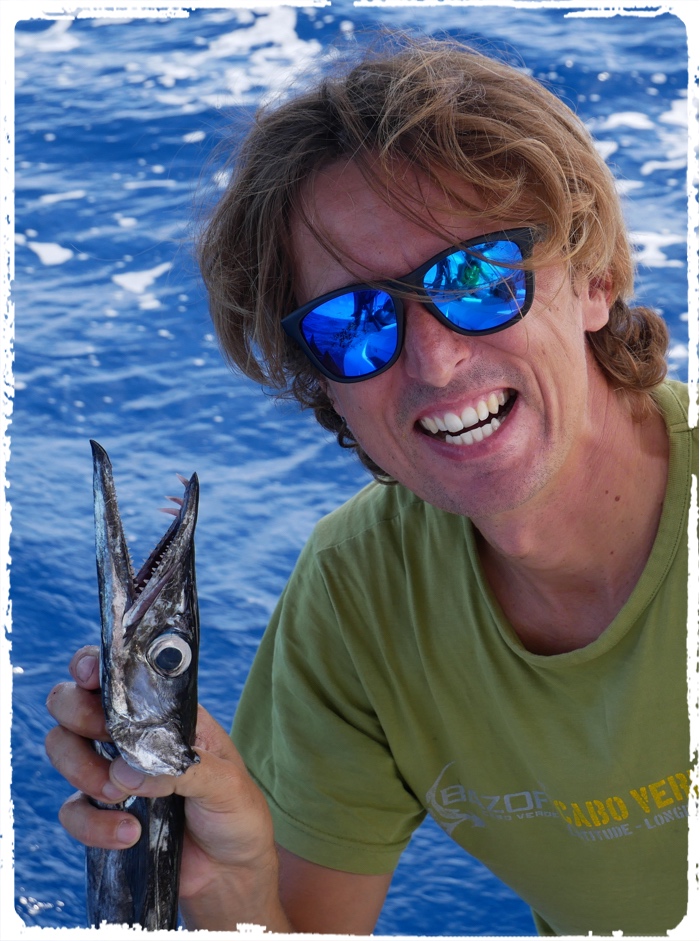
There are just ocean, sky and animals. Nothing more. Day by day. How does it feel? Perfectly peaceful and exactly as it should be. Strangely, there is nothing missing. Days go by surprisingly quickly and hours pass watching the sea and the waves, birds or sails. The kids spent the days building everything one could imagine with Legos and playing with created stuffs afterwards. If our first lieutenant wanted to have school with them, they would protest they didn’t have enough time to play:). I guess they accepted the fact that they would not see land any time soon and didn’t even bother asking how far we were or how much days of sailing were there left. What date is today? How long are we already sailing? Will the whole passage be so bearable? What will we have for lunch? A lot of questions were on the table and we were often considering us lucky that we left the right time and caught really good weather window. I guess our experience would be very different with different weather conditions or with some boat troubles.


The only 2 things that bothered us was chafing and showering. We could not take a shower every day because our water maker was useless during the passage due to the too much rolling. So, we showered ourselves when the smell was already unbearable:). The chafing is a problem that all sailors have during long passages. It is the situation where all small touching of ropes with some other rope or metal or any obstacle results in rope failure since this rubbing is 24/7 for weeks. The female part of the crew also regretted not having brought more fruits with us as we ate it really a lot at the beginning and were not having enough in the end. Some additional apples, oranges and mandarins would be great. We definitely bought a lot of them, but the problem is 3 weeks also is a lot of time. What we learned for the next time – math is useful when buying fruits for the passage and 4 large pieces of fruit x number of crew x expected time of voyage plus a week seem to be the right equation.


Our Genaker fell in the water 2 times since the toping lift failed and to get the 170 m2 Genaker out of water in the middle of Atlantic is quite a task! After the second water rescue we decided to put the Genaker away and went with the wing on wing formation. We were a bit slower but also the wind picked up so we were again surfing with 8 to 10 knots towards our destination.

As sailing towards Barbados continued, the highlight of the day for our Captain was to enter the log data with the position and miles sailed that day. Each evening we had a competition guessing the miles sailed that day. Our best score was 190 miles per day, our worst was 105 miles per day and at the end our average speed was 6,8 knots. With this figures we crossed the Atlantic in 17 days and 20 hours and sailed 2922 miles from Las Palmas to Barbados. We came to Barbados, our first Caribbean island, but before exploring it we first had to adapt to the green color and other people. After the 2-day rest we explored the island which was really funny with very nice and helpful Bajan people.
Somehow we feel like we were in a time capsule during the passage and we have one month missing. Of course, we realize it is already December but we don’t fully understand it:). We have now 6 months to explore the Caribbean islands and we are really looking forward to experience this leg of our voyage.

See you next time!
After 6 months of cruising in Mediterranean Sea, we will enter the Atlantic Ocean. But before we do that, we would like to share with you our Spanish experience. Our first stop after we left Italian waters was beautiful Balearic island Menorca. We liked the island’s walking paths, especially the one circulating the entire island. The path is very old and it is not clear who made it but it is known that it was used to protect the island. We immediately started fantasizing about spending our spring holidays walking along this beautiful path after we get back to our ordinary lives:) The prices for berthing were different here, skyrocketing up to 300 euros per night. Since we prefer anchorages and are fully self-sustained with electricity and water, we did not need to go into marina in the Balearics even once which means we could spend more money for food. That made our first lieutenant really happy and the first to try was fish and lobster paella. Our first anchorage was in the perfectly protected anchorage near Mao town. Our job was to repair our radar mount since in the passage between Sardinia and Menorca our existing mount for radar broke and only the electricity cable prevented the radar from crashing onto our deck. Needless to say, this happened at 3 AM on the only night we left gennaker up during the night (even though the first lieutenant was against of that captain’s idea), with wind picking up to 20 knots, with sea starting to be high, and, and… So, the Captain had to go to the top of the mast because the lines that bring down the Snuffer intertwined with the dangling radar. The lines had to be separated and the radar temporarily tied to the mast as it was otherwise banging against the mast. A lot of bruises were produced that night…

At the anchorage, we also met the French / Belgian couple with two kids that had engine problems and were also waiting there for new parts to arrive and we had great time together. We exchanged dinners and visits so almost every night there was a boat party which the grown-ups and the kids both enjoyed very much. Together we explored Menorcan south coast with clear waters and nice little bays with sandy beaches and walking paths.

The bad thing was that the whole south part was very rolling and after 3 days, we had enough and at 10 PM decided to sail towards Mallorca and its well protected anchorage in Port Polensa. The sailing was upwind and quite comfortable and 3 hours later we arrived and guess what, the sleep was firm as the boat… It was again time to explore Spanish culture and culinary habits. We liked the tapas, paellas and very cheap and good vines that are available in the supermarkets. At this anchorage, also the Slovenian cruisers arrived next to us that have been cruising for 6 years now, have circumnavigated the world and are now heading towards home for boat maintenance projects. It is funny how quick Slovenian people find each other due to the fact that we are very small country and act almost like community on the national level. Thanks again to Vesna and Toni for the barbeque night! The Mallorca also offered us very nice walking paths so hiking was on our daily agenda.
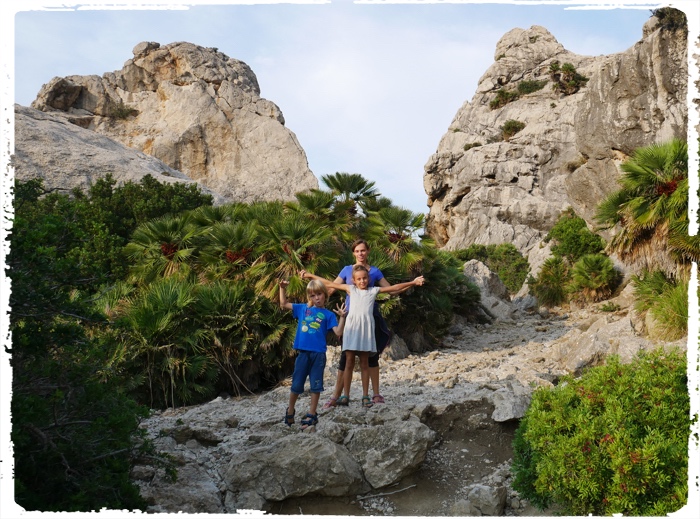
The swimming in Mallorca was quite tricky since there were a lot of jellyfishes. The Captain and Lana experienced their hurtful touches and cried for dingy rescue. With the hot water and vinegar the pain quickly went away. Our guest Katja hates the vinegar smell and asked to be treated only with hot water in case of an accident. Lana looked at her in surprise asking if she prefers boiling water over vinegar:)

When we were in Mallorca there was a basketball European Championship and that means that all the crew were watching the games and there was a lot of heat below the deck. In the end, we won and this matters!!!

The next destination was party island of Ibiza so we left Mallorca at 5 AM to do the 75 miles stretch of sailing. The wind was in our favor so we blasted towards Ibiza averaging 7,5 knots.

As the wind turned and to have the optimum angle of it, we turned towards the island Formentera which is just beside Ibiza. Formentera offered us very scenic and calm anchorages with clear blue, almost Caribbean waters.

We spent almost a week in Formentera and enjoyed the peaceful days and nights. It is strange that the Formentera is so close to the Ibiza and there are no signs of big parties that are happening every day in Ibiza night clubs such as Patcha, Amnesia and others. Just when you are on the beach during daylight, you can see some tired party animals ashore imitating the sea lions. Besides that, Formentera offers miles of sandy beaches so kids were having a blast!

At the Formentera anchorage, we were anchored next to the huge sailing boat A that was 148 m long and really futuristic. At the beginning, we all stated how ugly it is but we liked it more with each passing day. We gave her a nick name “Darth Vader’s ship”. I think the owner would not mind since he likes to be in power:)

We had spent a beautiful month in the Balearics and it was time to head towards the Spain mainland and Gibraltar as we have a plan to be in Gran Canaria until the end of October. Our first sailing was a 150-mile sail to Cartagena. Actually, we sailed just half of the time. One day was completely calm and we had to use motor for 70 miles. As an reward, we entered the marina in Cartagena and this was our first marina since Sicily and in almost 3 months. The town offers very nice city center. We especially liked the maritime museum where you can see the importance of the Cartagena in the last 3000 years. The museum is perfect for the kids as there are lots of experiments presented, games offered like matching cards with different amphoras and ships, and cartoon videos available presenting the old way of living. This was the first museum the kids refused to leave.

Since the whole south part of Spain was once Islamic there are a lot of oriental influences evident. One of them are Moorish castles such as Alcazaba de Almería we visited. A lot of movies were filmed here. One of our favorite was “A fistful of Dollars” with Clint Eastwood – we had movie night one week later.

We also started fishing and we had a lot of success with Tunas. There must be a lot of tunas here since we caught the fish almost immediately when started trolling. This was the first time we actually had to ask the Captain to stop fishing as after half an hour we had enough fish for days. Our guests were on a fish menu almost all week and told us they would return to their meat menu as soon as they got home. What we found out was that we need the stronger reel for the oceans since also the fish is getting bigger and bigger as we are approaching the Atlantic Ocean.

The passage to Gibraltar was 170 miles long and again we used a lot of motor since the wind was surprisingly low. At least we had a very smooth ride with no waves. As we were some 20 miles away from Gibraltar, the thick fog formed and it was quite scary with 0 visibility and in the area where a lot of tankers are heading towards Mediterranean or Atlantic Ocean. We were constantly hearing the sounds from fog horns and thanks to the AIS and the radar the ride was possible and without the two we wouldn’t dare to continue.

As all the marinas in Gibraltar were completely full, we went to the nearest one in Spain in La Linea, since the Hurricane Ophelia was very close to us and we wanted to be as secure as possible if the hurricane somehow gets closer to us. The interesting thing about it was that this hurricane was the most easterly one ever recorded so better safe than sorry. After the rain and wind settled, we explored the Rock of Gibraltar. It was a long nice walk and the views are incredible. You can see African continent on one side, Mediterranean Sea on another, Atlantic Ocean on third and Spanish flatness on the fourth. At the top, we were greeted by curious gentlemen which are an attraction that nobody visiting Gibraltar wants to miss. They are unbelievable. Lana commented that they are able to unzip a rucksack in search of food faster than a human. Seen several times...


With the visiting of Gibraltar, we are ending our voyage in the Mediterranean. The next destination are the Canaries where we will prepare for the Atlantic crossing, our first Ocean crossing. We all (at least the Captain) are very excited to do this crossing and also a little afraid (also the Captain) how it will go. To sum up the Mediterranean, we have sailed 3200 miles and spent 200 beautiful days in this part of our world. We did not have any bad experience and no security issues whatsoever. We hope that the rest of the voyage will be just as exciting as it was here but we think it will be even more interesting since we will visit much more exotic and remote places with completely different cultures.
See you on the other side of the Atlantic!
In the last month and a half, we were feeling rather tourist agency than cruisers, since we had 6 visits for 1 week per visit in a row! We liked them all but at the end we were quite tired since every visit means devotion and special treatment that we don’t have if we are alone since we are too lazy:). But it was a holiday season and still not far from our home so our friends and families took this advantage and visited us now.

We spent almost 3 months in Greece and for us being there was an excellent experience. We will definitely come back sometime since there are so many other places to visit that we have not visited yet. We did not even once see a stressed and unhappy Greek! And locals also have huge respect to each other, young people to their elderly and to their visitors what welcomes you and gives you a feeling of being home.

With visitors, we didn’t make a lot of progress towards Gran Canary where we are headed for our Atlantic crossing. A friend of ours tracking our way all along commented that we seem to get lost between Greek islands as the track shows we jumped from one island to the other and then back to the first one and so on:). We assured her that our navigation system didn’t break down and that we were just picking guests at the islands with best ferry and speedboat connections. Our Captain got travel fever and started planning the crossing to Sicily. First, we had to come from Crete to Peloponnesus because the prevailing wind angle from Peloponnesus is usually better if you want to cross the Ionian see directly to Sicily.

After we left Greece there was a 300 miles’ passage in front of us from Peloponnesus to Sicily. Actually, at the end it was near to 400 miles due to the wind which pushed us closer to the Africa than expected… Needless to say that the wind prediction wasn’t really accurate:) Nevertheless, the passage was very pleasant with quite calm seas except that we motored almost half of it. We also earned some kind of Darwin award – we decided to stop the boat, to have a good swim and to make ourselves lunch before coming to Sicily. After we were done we hoisted the sails and started having really nice last miles sail towards Syracuse, when all of a sudden the high-speed police boat approached us and said that they will tie beside us for inspection. At the beginning, they were really suspicious and we wondered if this was a common practice. They even wanted to search the boat and we allowed them to do so and they did it in really professional way. Once they saw that we were not some kind of smugglers, they became extremely friendly, took the picture with us and chit chat. Their boat had 4 times 700 HP engines and they decided as Proper Italians to make a show for us – they went away for 0,2 miles and with full throttle charge directly to Zana and in the last second turned 90 degrees so their boat turned less than 10 meters away with 70 knots!! We were all excited and afraid at the same time... So, the Darwin award is the fact that they followed us for two days waiting when we would come to Italian Territorial waters (that is 12 miles off the shore) and we stopped for a swim and to make our lunch just 12,1 miles of the shore (of course we did not notice that…). It is obvious that they thought we were some kind of professionals knowing that as long as we stay in international waters they cannot touch us!!:)

The first place to visit in Italy was Syracuse with the safest anchorage in Sicily which was really calm and secure. As always we went to the shore in order to find the coast guard for clearing in. The coast guard was closed but had a small home-phone to call them and after we made an audio contact we said that we came and wanted to clear in to Italian Waters. They were confused just as we were and did not understand what we want… After some explanations, they just said: it is free to sail in Italy, no formality needed! After some doubts, we found out that since we were in Schengen area there was no passport check and that in Italy you don’t need to pay anything to use Italian waters, which was super cool and something new to us!!
In Greece, they all scared us how expensive the Italian marinas are and that there are no anchorages so you are forced to use the marinas. They were quite right but not entirely. If you try a little harder, you can find some decent anchorages and also some reasonably priced marinas (in the whole visit of Sicily we were only once in marina which was basically a yacht club and therefore priced very good – for our boat 55 Euros per night which is still much better than in Croatia:).
Our first impression in Italy was that it is much more crowded than Greece, much louder and that it offers different cuisine experience. We liked Italian street markets which were full of good stuff and shouting people so they look like very good organized chaos.

We were playing with the idea what to visit in Sicily and we were all for Aeolian islands as we wanted to visit their volcanos. If we wanted to get to those islands, the first task was crossing the Messina straits. This strait is notorious for their currents and we also experienced some of them. With constant RPM we motored some time with the speed of 9 knots and a few minutes later just with 3 knots… Also, our autopilot had some work to do in this confused seas.

Our final destination, island Vulcano in Aeolian archipelago was reached right before dark. We set our anchor in the bay of Ponente and noticed strong smell of rotten eggs – it was the Sulphur of the volcano activity and it was not very pleasant so each of us had some special dreams… Since it was a very hot period, we decided to go to the volcano crater early in the morning and the Captain did a splendid job to wake up the crew with smiling faces:)

Slowly our time in Sicily came to an end and it was time for us to head towards Sardinia. Before that the Captain decided finally to buy some fishing equipment since the Crew wanted fresh fish from the sea. In the passage to the Sardinia (200 miles) we started to troll and had our first fishing success, little Mediterranean Dorado which is substantially smaller than those from big oceans. Nevertheless, it was delicious...

Our passage started with a very good wind and we sailed with some really high speeds but then slowly the wind started to die and we were forced to burn the diesel for the last 70 miles.

Now it is time for relaxing and enjoying the clear Sardinian waters…
See you next time!!
After two months of sailing in Cyclades, we started to get the idea how these islands breathe, and they breathe strong. The islands are for sailors either paradise or nightmare. Paradise for those who are medium advance or advance skippers who not just know how to handle with the strong winds but can also sail wisely (listen and take care of the wind warnings) since there are numerous shelters for all kind of winds although it is interesting that in the typical anchorage the wind blows even stronger than offshore… But can be a nightmare if you are in hurry, ignoring weather reports and don’t know how to rig a boat for winds of 40 knots or higher. As a reward, the islands will offer you clear water, sandy beaches, helpful locals, good local food and lot of hiking routes with astonishing views.

We were hiding in the port of Ios from a strong northerly (they blow with gusts of over 50 knots!) and saw damaged boats even in the port (the ports in Greece are usually stern to with anchor so if the wind is blowing in your nose and anchor drags...). We were lucky to find a spot with mooring in relatively sheltered part of the port.

There are so many islands in Cyclades that we immediately knew we can’t see them all. So, we let the wind choose which to visit. The first Island, Kea, showed us that these islands will be scarce with vegetation and from the distance they all look the same. But when you get to know them better, every island offers some specific surprise. Walking routes are a wonderful way of getting to know these islands, if the sun allows, as they give plenty of time to observe and admire.

Apart from the sightseeing we also started to feel that we are changing. Changing in the good way we think. We slowed down quite a bit and we catch ourselves looking at sometimes grotesque pictures of the running and stressed tourists who have just 10 days to see it all and are more carefully organized and timed as one would have been if working in some big corporation. I think also our guests notice this but most of them are wisely quiet:). We are often asking ourselves which day it is (especially when we are expecting guests as we really don’t want to miscalculate their arrival time) but at least we still know which month it is.
Our passion among Cyclades were walking routes. Since as a cruiser you often drop your anchor in bays with no transport available, the only option to get somewhere is by foot. And there are very nice walking routes almost everywhere. We liked hiking in islands and collecting herbs while on route to the town. It is amazing how locals in the past were organized and cut the paths sometimes directly in hard volcanic stones in this hot environment.

When cruising, Lana and Zan have less opportunity for socializing than they would have at home with “normal” life. Therefore, we use every opportunity if we see some children and encourage ours to join them and start playing with them. We were lucky to meet Slovenian cruisers on board of SV Siesta who also have two little girls. I don’t know who was happier for the company:).

But apart from Slovenian children also the native ones are very kind and willing to play with the strangers. As the child language is universal, they can quickly find a way to play. In Ios Lana made friends with a few girls of her age. She was brave enough to ask if she could play with them and they immediately accepted her. They stopped playing, welcomed her, introduced themselves and explained her the rules of the play they were playing. They spoke English well enough to be able to communicate. They were playing ball games all afternoon and Lana was above ground level all the way back to our boat because she was so happy.

Big share of our time is also rolling around food. Since now we have more time, we mostly cook and go out quite rarely. Usually we visit fish market, vegetable market and sometimes also butchery to stock up and then we are ready to prepare the food with local ingredients which in Greece are very tasteful. We have to encourage our main chef to prepare also some meet among the vegetable soups and salads which are equally delicious but sometimes we just need some extra power to survive through the daily water activities.

We decided to prepare our own marmalade and tomato sauce for pasta since the ingredients on the market were all local and very rich with taste because of a lot of sunny days.

Our next destination is the largest island in Greece, Crete. We raised our hook at 5 am and quickly raised our sails with 2nd reef on our main, since the wind blew 30 knots sustained. But after 1 mile from the anchorage the wind suddenly dropped to 5 knots. Captain was starting to be angry at the Eol so Eol was graceful and soon gave us steady 20 knots at beam till the end. 100 miles’ passage was done in 12 hours which gives us 8,3 knots in average. Not bad at all. Also, the crew liked this passage a lot as despite the wind the sea was not too high so the sailing was very comfortable.

See you next time!
Now it is close to two months since we started with our journey. It happened for the first time that when we were heading back to our boat from long walk on the shore, we used the term “home” instead of “boat”. So, we now officially have a floating home!
We have been sailing in Greece from the beginning of May and we love it. For numerous reasons. Our captain loves that there is always wind as he dislikes the sound of a motor running and is delighted to see our diesel supply intact:). Waters in Greece are very clean with a lot of shelters so you can always find an anchorage if you want to throw a hook.

But definitely the most important reason for all of us are people. Greek people are kind and communicative. They are smiling and talking to each other most of the time and prepared to start a conversation with us anytime. They are very happy when boat approaches a shore and they will almost always help you with docking. The first word is not about fees – it is the welcoming Kalimera. On a lot of occasions berths were actually free – only electricity and water were payable if needed (since we have our own power plant and reverse osmosis for water we didn’t even need that service). Bus driver got out of his bus to help some tourists figure out which bus they need and to show them where to buy tickets and lady selling tickets got out of her office to show us the right bus when she saw that we didn’t have any idea which one is the right one… We were buying oranges in one of small shops and came out each with a biscuit that the lady running the shop had baked just a little before. And the list of little surprises just goes on and on… We feel very safe here.
And as we really like to eat well, the next reason for loving Greece is food. Food in Greece is awesome. Oranges are from local farmers and they are veeeery tasteful, juicy and sweet. There is plenty of fish and vegetables – all local products. Their dairy products from sheep and goat milk are mmmm…

Lana and Zan love Greece for their sandy beachesJ. They can play for hours building sandy sculptures or just jumping around in water. It is perfect for Zan who is trying to learn how to swim.
But first thing first, we had our first celebration on the boat, Lana’s birthday – happy birthday Lana!!!

Our boat is working great (someday we will tell more about our boat, for now, it is Beneteau first 47.7, very fast cruiser, some are call it performance cruiser, we will see:)) with some minor glitches like one day we found out that there is a lot of salt water inside the boat – the captain started to panic that the water had come inside around the keel. Fortunately, just one of the side windows that is under water when you are extremely heeled during sailing was leaking. It took one day to reseal all six windows, other five of them just in case. Also, the next day we had another flood – this time it was fresh water. It turned out that the main pipe of the plumbing system was leaking. 2 hours later (and after some dirty words), also this problem was fixed.

In Greece, we started with Ionian islands and visited Erikousa, Corfu, Paxoi, Lefkada, and Ithaka. We liked them all, maybe Lefkada the most – it was so green and peaceful. Captain’s goal is to test Gyros Pita at every location we stop, so far the best was in Ithaka… The sun finally managed to warm sea enough so we can enjoy short swims and during one beach visit, Lana managed to catch small octopus. We had some hard time convincing her that octopus is not most suitable as a pet.

Our first Lady stated that we almost ran out of our fresh supplies so the captain lifted the anchor and headed towards Patras, 3rd biggest city in Greece.

This was our first night in marina in Greece and given the prices of marinas in Slovenia and Croatia we found this one very inexpensive, little more than 20 euros per night and City center just 2 kilometers away. We were a little confused at first since there was a lot of traffic and noises – we spent the last month more or less on deserted anchorages… But city life definitely has pluses - we were lucky to arrive just in time to see their show on the shore with traditional music and dance.
Our next goal was to cross the Corinth canal. It is impressive how narrow and long the canal is, especially as it was made without the heavy machinery that we have today! Good bye Ionian and welcome Aegean Sea.
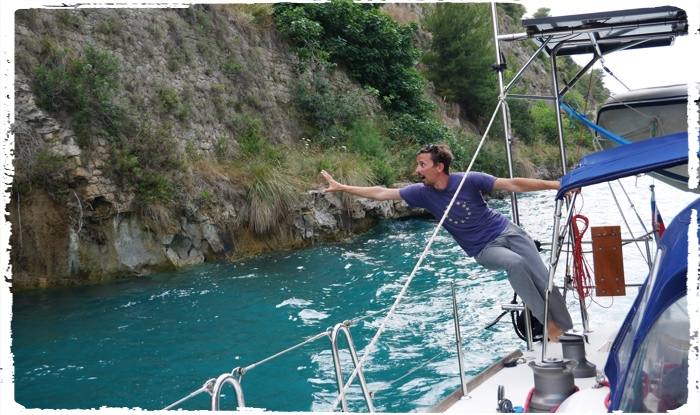
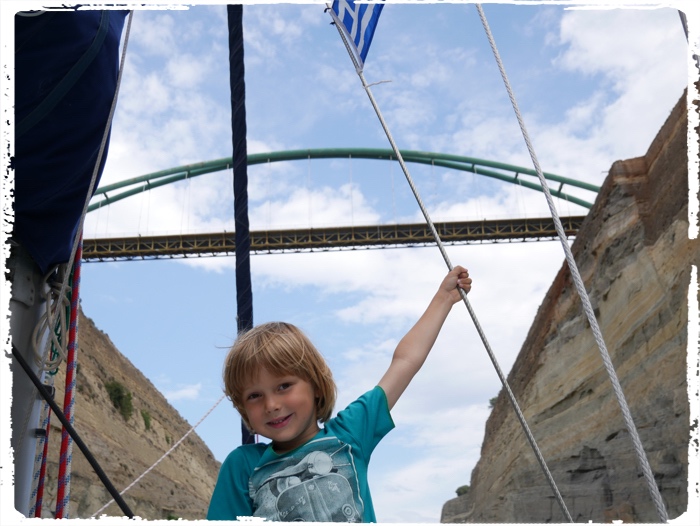
First we planned to visit Athens but Athens as a very big city is crowded with all kind of ships and also offers no anchorages. We decided to anchor at the nearest Island Salamina and go with the 15 minutes’ ferry to Athens. In practice this was quite a logistics project: with our dingy to the shore, then search for a Taxi to Ferry, with a Ferry to Athens port, with a bus to Athens Metro and finally with a Metro to city center:) We visited magnificent Akropola. Did you know that it was severely damaged as late as in 1687 when the Venetians attacked the Turks and opened fire on the Acropolis causing an explosion in the Parthenon, where the Turks were storing gunpowder?
Our next destination was the beautiful island of Aegina. We had a nice downwind sail to Aegina averaging 8 knots and we were there in just one hour. The town of Aegina is really beautiful and cozy. Aegina is specialized in pistachio farming so we ate them constantly and in every form: salty, in ice-cream, in cookies… Near the Aegina there is natural park Moni island. It is a beautiful place with a lot of fearless peacocks and roe deers – it sounded like Jurassic Park. Lana loves animals and this was her dream come true. She could feed them, even managed to touch one of them to feel what they were like and could watch male hitting on female. Very impressive…they really put a lot of effort to get what they want:).

Of course, our captain found the highest point of the island... and convinced us to go see the view from above. It was definitely worth the effort. All the views from above are outstanding. He had a plan to climb (with us?) on the highest point of our every island stop. Luckily, he is not too strict with this idea as some of the peaks really are high above the sea.

Back to Aegina we had another task to do, visit the ancient sanctuary of Aphaia. It is breathtaking how old and well preserved these big buildings are. It is part of so called sacred triangle together with the temple of Parthenon dedicated to Athina at Akropola and the temple of Poseidon at Cape Sounion, where we also stopped.
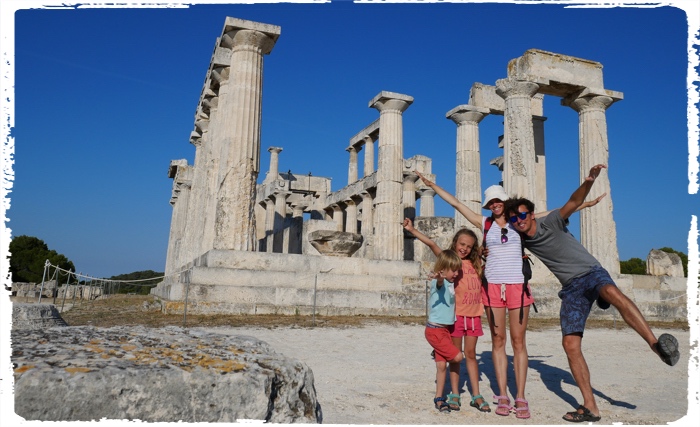
Our next goal is to explore Aegean islands and experience meltemi winds. See you next time!!!
It has been a while since we wrote our last blog, I guess our laziness comes with lower latitudes... A lot of things happened during this time and we also had first visitors on board!!! For one week, our boat became a ferry and I was feeling like the captain of big passenger ship. To calm our Captain down, we first had school about behavior on board: no fighting and pushing each other on board, no walking on deck while sailing, leaving windows in peace without opening them, jumping on them or kicking them, no playing with ropes, toilet rules, rules on low water consumption… All rules were accompanied with mostly real stories and their ears grew bigger and bigger:) Lastly, each one of them pictured one rule and we posted their warning pictures throughout the boat. They all turned out to be a great crew!

Our kids loved company. Lana and Mark established a band with Lana trying to play a guitar and Mark being a singer, Lana and Liam loved playing cards and Zan and Oskar were lost in Lego world for hours. Adults loved company for a beer (male part) and chats and slow jogging (female part). We were lucky with the weather so we were staying mostly at the islands of Dubrovnik archipelago like Lopud and Koločep. The idea was that we go to the mountains so children would become tired and would go to sleep soon so we, older members of the crew, could party. It turned out that our party was put on snooze too:)


Due to the strong southerly our sailing was always short (big waves) but intense. Our new crew members were a little insecure and starting to get seasick so Captain had to choose near and swell free destinations. This was the time when the sailing knowledge went into practice:)

Soon after our friends left, we were heading back to Dubrovnik to pick Captain’s parents, visit #2, who sailed with us to Montenegro. Lana and Zan really enjoyed their company and requested grandma to read them Greek myths every day. They read the whole book with 100 myths in only a week. Grandpa was teaching them math. We couldn’t wait to get to Montenegro since it is a land of grilled goodies like pleskavica and cevapcici. Immediately after our arrival in Montenegro and very pleasant check-in formalities, we were visiting Herceg Novi and the grill house.

Our friend was just visiting her parents in Herceg Novi, so we had excellent welcome party with great sheep’s cheese and spinach pie, sheep’s prosciutto, sweets and local spirit made from Vranac grapes (loza) – thank you Amanda!!
After we said goodbye to grandma and grandpa, we left Bari marina and started our first “big” passage to Corfu, Greece (150 miles). Since we had quite slim weather window, we had to leave immediately after the southern winds ended and turned to westerly which brought us big and confusing seas that led to seasickness of all the crew… We were like dead bodies flooded on the shore...

Lana and Zan were first to recover and could not understand why we don’t feel like eating. They were hungry but had to do with bread and apples as none of us felt like warming the soup prepared a day before. A few hours later the sea was starting to calm down and slowly we were coming back to life and were also able to prepare dinner. In the morning, we finally reached our first land after 24 hours, the island Erikoussa. There we recovered from the passage, ate delicious Greek oranges and had great time with Greek army who just arrived with huge helicopter and told us everything about their helicopter – they were also surprised at what we are doing so they all took a picture with us to show it to their wives and tell our story:). They allowed us to be around when they took off and the wind of propellers almost blew us away when they descended from the top of the hill… Zan was fascinated.

After the rest from the passage, we started to enjoy the Greek culture together with food and most important, Greek time which runs much slower…

See you next time!!!
We are continuing with the island hopping in Croatia. The weather serves us well and we have pleeeenty of wind so our diesel tanks are still full. Our first stop was the Veli rat on Island Dugi otok (eng. Long Island). This was our favorite stop since we knew that we would have a free internet, great showers and laundry machine! Showering is possible also aboard with warm water available only when the motor is running. So, the best time to shower is during or soon after motoring (when usually also everyone is hungry and something good has to be cooked really fast!) which is convenient also as hair dryer uses so much energy that it can also be used only when the motor is running:) Up to this point this is only a theoretical option as I have never been able to combine all of these things at the same time. Captain decided that we will go to the scout trip on Dugi otok. We explored the island and made a bow – extra motivation for the kids to walk long distances. We parents are full of tricks :)
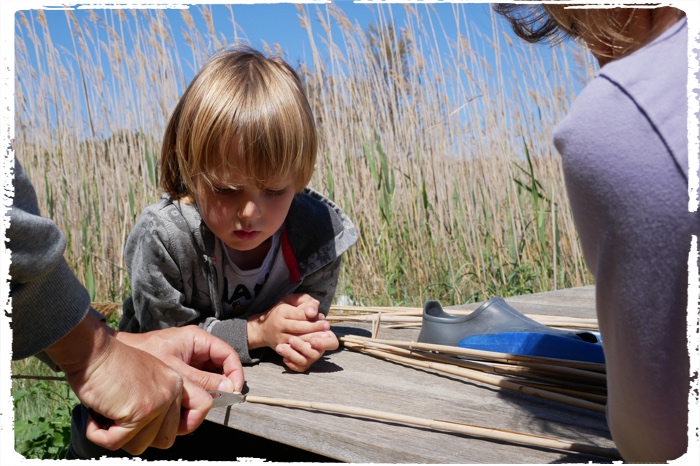

Also, our homeschooling began. Barbara is announcing every day the school hour and both, Lana and Zan are at the same desk resolving the tasks they are given by the unforgiven teacher. They are quite interested – who would not be having the individual class?
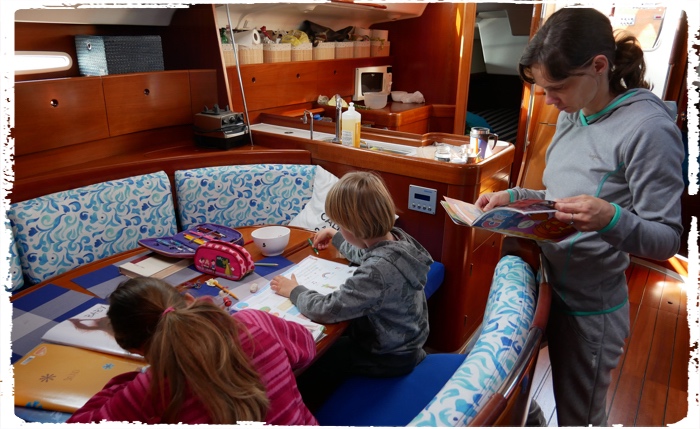
The next day it was time to sail towards Split where we had a minor repair of the Lazy bag in the plan. We sailed for two days (we sleep anchored) with the strong westerlies and had beautiful downwind sail. We also tested our new whisker pole and the Captain was happy and proud that it turned out good :)


We really enjoyed the Split town. We had convenient anchorage nearby bus station with the line directly to the old city center. The market of Split is full of local vegetables, fruits (lemons, oranges) and fishes from local fishermen so it was shopping time – and feast time! Lana found strawberries and couldn’t resist. We also found excellent ice cream and tried almost all flavors! In Split there is very big park that locals call it Lungs of the Split – it is beautiful hilly pine area with a lot of walking paths to the top of the hill that serves the beautiful scenery of the surrounding islands and other panoramas.

But soon, much too soon the Captain said that it is time to sail further. We were heading to the Mljet national park with short stop at the Hells Islands where Lana and Zan found their first starfish this year. We decided to stay longer here since the National park offers really nice scenery and walking paths – the water is still much too cold for the water activities so we have to find other ways to explore the island and to give our Captain plenty of exercise as otherwise he gets grumpy:) especially with the kids running around the boat with their endless energy:). It is said that the island was once home of the Ilyrian pirates as it was located near Roman sea path. They believe this to be true as numerous amphoras and galleys were found at the sea bottom along Mljet. The island is blooming with all sorts of wildflowers - 30 different orchids are just starting to bloom. We climbed to the highest point in the national park and since the Captain missed the right track, we actually climbed to the top! Kids of course liked it very much, but Barbara was not so happy :)


The next stop will be Dubrovnik, where we will meet with our friends and the boat will be crowded. Definitely, there will be a lot to tell next time!
We are slowly adapting to our floating home and nomadic living with far less obligations than we had back home on the hard. But we are not yet feeling the pure adventure since we are still in for us very familiar Croatian waters where we were cruising for many years in the past.
First of all, we are still under impression of our Good-bye party in Marina Izola (thank you Marina Izola for hosting our party!), where we said good bye to our family and friends. For us it was very unforgettable event just a little short to talk to everybody to the extent we wanted because the equation of the time divided by the number of the party attendants was just not in favor of long conversations. Anyhow, thanks again to all that came and we hope that you also had a great time!!!
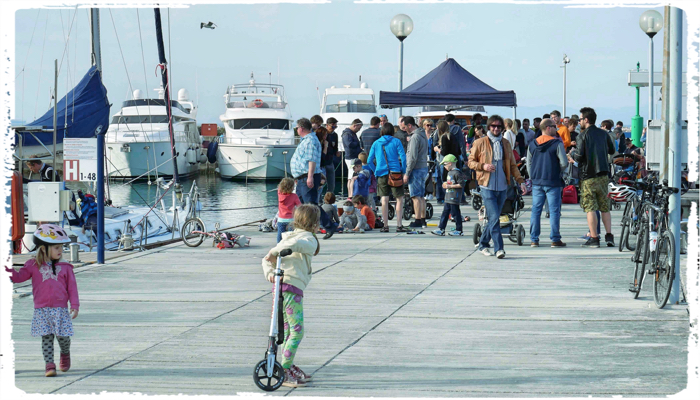

The next morning, we woke up with slight murmur in our heads quite early to settle the formalities with the customs where they already thanks to my dad knew of our intention so I think it took us 3 minutes to depart Slovenia, our homeland which we will not see for a looong time.

We know that during our first month of cruising in Croatia we will barely need any chart plotters or other navigational aids since we know this waters for so many years and travelled numerous miles here while spending almost every vacation sailing here. But anyhow, we are anxious to sail again here since the Croatian coast is spectacular with beautiful nature and old cities. The major challenge for the first month of our expedition will be the low temperatures since in this time of the year the temperatures are below 10 degrees Celsius over the night, brrrrrr. Another challenge, that our Captain however is denying, is washing clothes. Our boat is not equipped with a normal washing machine like we have at home. We have a “funky style” washing machine that in my opinion is able to cope with underwear and socks (also that not yet checked) and not with all the clothes used at such temperatures. Currently, we use washing machines we can find on our way. And as this is not really a challenge in our Captain’s opinion all the crew got strict instructions from the Captain: we can only change our clothes twice a week. We have however manage to negotiate changing underwear and socks every dayJ.
Our first sightseeing stop was the Brioni national park – former residence of Tito where he hosted his friends like Elizabeth Taylor, Jackie Kennedy, Sophia Loren,… hmm I don’t know what his wife said??? On this Island, there is also Safari - a magnet for our kids who enjoyed seeing the animals and long walks (haha). They were especially fascinated by the deer family, pheasants and rabbits they saw walking around free during our evening walk.

The weather window told us that it is time to cross the Kvarner and the Captain announced that he will woke up at 7 AM to start with the mission. When the crew woke up two hours later, the Captain was just arguing with the police and we were motoring in complete wrong course directly to Italy some 10 miles offshore. The situation was that we were in the middle of the military polygon and we were disturbing the military action (there were no warnings on channel 16 whatsoever…) so in the end the military decided to give us an military escort so nobody would us for a bombing target :)

After we were out of the military zone we changed our course to the Island Unije where we anchored for the night and our first lieutenant ordered that we had to collect some wild asparagus for dinner. If swimming is not essential for your holiday, we strongly recommend visiting these Islands in spring for a change (for non-allergic :)!). Everything is in blossom, including conifers, and we had the feeling of being bees. Only a short walk changed our shoes to yellow of all the pollen.
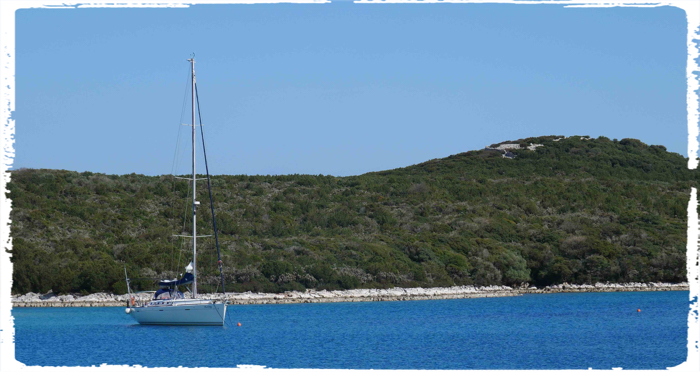

There was 35 miles of sailing from Unije Island to Dugi Otok Island next day and the conditions were perfect as we had downwind sailing at 10 knots of wind doing some 5 to 6 knots with wing-on-wing formation – couldn’t be better. When we anchored, we tried to catch some fish for dinner but the first fish we caught was the most poisonous (and also delicious) fish in the Adriatic Sea, the Weever (morski pauk). This fish has venomous spines. The poison is not lethal but would give you severe pain for a long time so we took a great care to unhook her.

During the day, weevers bury themselves in sand, just showing their eyes, and most injuries incur due to stepping on her spines.
Our plans are to reach the Greece by start of May so we still have plenty of time for exploring Croatian coast and the coast of Monte Negro. See you next time!
Finally, our boat is ready!!!
On the 1th of April, there will be a good-bye party, so if sailing is your passion or you want to say good bye, you are invited!!!
Party location: Marina Izola 45°32'07.8"N 13°39'13.4"E
Party time: 14:00 UTC

